Dealer angst rising over listings prices
Businesses warn Trade Me Motors’ restructuring of advertising packages is becoming ‘unaffordable’
Car dealers unhappy about upcoming price rises to list vehicles with Trade Me Motors are increasingly looking at alternative advertising options with some complaining bills from the website are now their biggest operating expense.
A number of traders have seen the cost of packages with the platform making regular doubledigit percentage jumps in recent times.
The last hike came in September 2023 and some dealers say they now face having to pay an extra 30-plus per cent to remain on similar deals from July 1.
Trade Me is offering a range of newly named packages from that date and is also ditching the option to have super features on listings, which help bump them higher up in search results.
Dealers who spoke to Autofile about what’s happening describe the looming price increases as Trade


unaffordable and claim the new plans appear to offer little extra value.
As a result, they are looking at cutting how much they spend with Trade Me, and putting more resources into listing on other websites and improving their social-media strategies.
Trade Me Motors says a new pricing structure has been created because its advertising plans from July will be based on how
prominent dealers want listings and what extra features they would like.
It’s doing away with its previously named packages, such as bronze, silver, gold, platinum, platinum plus and total boost. Instead, it is offering lite, standard, enhanced, premium and ultimate deals, which it says allows traders to pick an option to suit their budget and desire for prominence.
Lachlan Hammond, sales manager of Tony Hammond Motors




[continued on page 4] GLOBAL VEHICLE LOGISTICS NZ - JAPAN - AUSTRALIA - UK - SINGAPORE MAY 2024 www.autofile.co.nz THE TRUSTED VOICE OF THE NZ AUTO INDUSTRY FOR NEARLY 40 YEARS p 23 Omoda Jaecoo’s New Zealand launch Land-transport policies under scrutiny p 10 Kiwi’s first national rally win p 29
Tribute to Sir Colin Giltrap p 18
Me Motors says its prices from July will be based on how prominent dealers want listings plus any extras
BIGGER IS BETTER







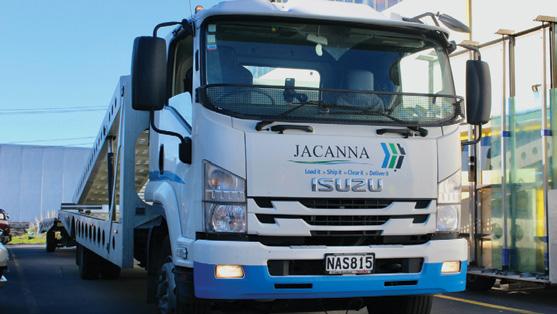

move to new, much larger premises means we are to offer even more services to our dealer clients

Capping it all off is Jacanna’s SmartTrade Rewards Programme, you can earn points for almost any reward you choose to door ro-ro vehicle shipping from Japan and Australia Containerised vehicle shipping from anywhere in the world Vehicle tracking


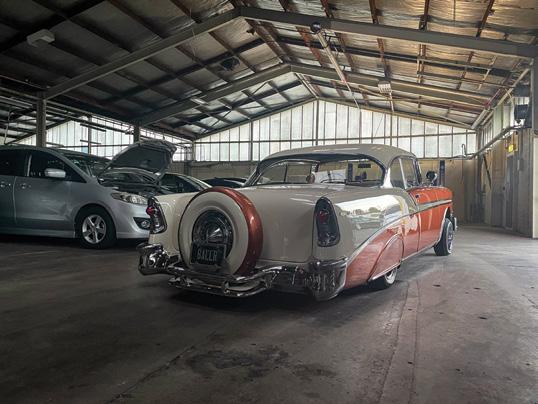

VEHICLE SHIPPING
MPI transitional facilities and cleaning services
We are specialists in transporting and exporting all types of Vehicles, Commercial trucks, vehicles of Special Interest and other RORO Heavy Cargo & Machinery.
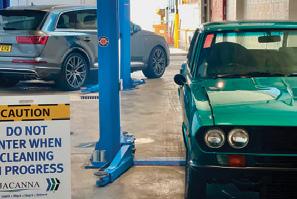
GENERAL FREIGHT
We have developed a worldwide network of Agents who understand the commitment required to service our demanding market.

www.jacanna.co.nz Tel: +64 9 825 0888
VEHICLE TRACKING
Finding out where your vehicle is at any one time of the process, gives you the ability to manage the collection and processing of documents and payment on time.
SHIPPING SCHEDULE
TRS and shipping services from Japan to New Zealand.

JACANNA.CO.NZ
Approved
LOAD IT SHIP IT TRACK IT CLEAR IT DELIVER IT !
Terms and conditions apply.
www.jacanna.co.nz info@jacanna.co.nz Tel: +64 9 825 0888

Outrage over taking trades off green list
Lee Marshall says ‘already critical’ situation with labour shortage will probably worsen
We’re still fuming over the decision to axe panel beaters and vehicle painters from NZ Immigration’s green list.

The decision dropped on a Sunday afternoon early last month with no fuss or fanfare and with no consultation with industry. I’m yet to speak to someone who wasn’t blindsided by the announcement.

are simply no local shortterm solutions to this problem.
DIRECTORS
Darren Wiltshire dazzz@autofile.co.nz ph. 021 0284 7428
Brian McCutcheon brian@autofile.co.nz ph. 021 455 775
DESIGNER
Adrian Payne arpayne@gmail.com
To say we’re disappointed is an understatement. The MTA worked very hard with the previous government to get those roles on the green list.
We did that because members told us forcefully that the labour shortage was the number-one issue keeping them awake at night.
For collision-repair members, it still is. Some 92 per cent of them recently said it was a “significant” or “very significant” issue in their business.
We have asked members for their thoughts on this government’s decision to unwind the changes we fought for so hard. They didn’t hold back.
“We have waited so long for a business-centric government and this is the result,” one said. “Disgustingly tone deaf on their part.”
Another commented: “Businesses have closed up in our region because they couldn’t get staff. This constraint will drive us out of business.” A third added: “Just one more kick in the guts for us as SMEs in this profession.”
That’s strong stuff, but completely understandable as the green list was a lifeline for many collision repairers because there
We would all like to see more young Kiwis enter the industry. But if the government’s intention is to attract and nurture local talent, it faces an uphill battle. As one member pointedly asked, why would anyone want to enter the industry when they can earn more as a building labourer.
The collision-repair sector wants to pay good wages to its people and mostly does, but it’s hamstrung in what it can offer by the dominance of insurance companies.
According to the Collision Repair Association, our industry is about 1,000 people short. That’s why we need overseas workers and why we campaigned so hard to get them on the green list.
Overseas workers aren’t unskilled, cheap labour. They’re experienced, knowledgeable and hard-working. They contribute to communities as well as companies.
That’s an important point because not only businesses are affected by this. Motorists across the country are experiencing lengthy wait times for vehicle repairs, in many cases extending into months. This issue, already critical, will now almost certainly be made worse.
I’ve written to Erica Stanford, Minister of Immigration, asking her to reconsider and reverse her decision. We will ensure she knows exactly what our members think. Of course, if she needs to take her family car to be fixed, she might just find out for herself.
EDITOR
Darren Risby ris@autofile.co.nz
JOURNALISTS
Matthew Lowe matthew@autofile.co.nz
Sue Brebner-Fox sue@autofile.co.nz
MOTORSPORT
Mark Baker veritas.nz@xtra.co.nz
Visit www.autofile.co.nz to subscribe to Autofile magazine and have it delivered monthly in print. The subscription rate is $78 plus GST for 12 issues per year.
Autofile magazine is also available online as a readable file or downloadable as a PDF.
Back copies dating to 2017 can be found on the website where you can subscribe to our Insight email alerts.
Copyright: Published monthly by 4Media Ltd
All statements made, although based on information believed to be accurate and reliable, cannot be guaranteed, and no liability can be accepted for any errors or omissions. Reproduction of Autofile in print or digital format in whole or part without written permission, whether by copying or any other means, is strictly forbidden.
All rights reserved. ISSN 0112-3475 (print) ISSN 2350-3181 (online)


www.autofile.co.nz 3
Vehicle Inspection NZ Entry Certification Specialists 0800 GO VINZ VINZ.CO.NZ • Entry Certification • Vehicle Appraisals • Pre-Purchase Inspections • Warrant of Fitness (WoF) • Certificate of Fitness (CoF) • Road User Charges • Registration & relicensing • Exhaust emission testing Call Steve Owens now on 021 947 752 GUEST EDITORIAL
LEE MARSHALL Chief executive officer Motor Trade Association
in Tauranga, says his company would have to find an extra $2,300 plus GST a month to remain on a package similar to its current one for 25 vehicle listings.
“We have been on the platinum 25 this year, which is $5,500 plus GST a month, and Trade Me recommends we should go to one that is $7,800 plus GST a month,” he explains.
“Instead of the company’s recommendation, we’ll stay on the cheapest package, which for 25 cars is about $2,300 a month, and also put listings on Auto Trader.
“We will broaden our range of advertising and marketing. The rest of the money we save we will put into a social-media specialist. We’ll see what results we get there.”
Hammond describes the latest price hikes as frustrating and says they risk becoming unaffordable for his company. “It’s now a bigger expense than our property. It feels like you’re working just to pay Trade Me.”
He doesn’t believe there have

been enough developments in Trade Me’s systems to justify the latest price increase, and laments a lack of general support from the company and its reps.
In the past, some advertising outlets would help businesses write listings and take photos to better present vehicles for sale.
Hammond claims Trade Me offers no such services and does little to help sell cars “other than just being a digital billboard”.
“I still want to use the platform – about 50 per cent of our deals come through Trade Me – but the first time, last time and every time I’ve been visited by a Trade Me rep it has been about increasing our advertising costs,” he says.
“There are reports of some good alternative listings sites taking shape. We hope those will create some serious waves in the New Zealand market.”
He’s also unhappy with Trade Me offering discounts for dealership groups with five or more branches. These range from five per cent for companies with five to nine yards and up to 10 per cent for those with 20-plus sites.
“It probably thinks if one or two little guys cut it off, it won’t miss the money but if the big groups go then that will hurt Trade Me,” adds Hammond. “As long as the big guys are on the website, then the little guys will likely stay there as well.”
SEEKING ALTERNATIVES
Andrew Farrow, director of Eyrewell Forest Motor Company near Rangiora, is also hoping alternative sites will gain more traction after being disappointed with Trade Me’s service in recent years.
Like other dealers, he will be looking at different advertising options ahead of July’s pricing changes coming into effect.
“We advertise on radio, in magazines and on our own website, as well as Facebook and Instagram pages,” says Farrow. “We may have to put more effort and energy into those channels now.
“If Trade Me was providing a good product at a reasonable
price it would be okay, but I feel it’s offering a substandard product at an exorbitant price.
“It is becoming apparent that dealers want another platform to compete with Trade Me. If a viable alternative was available at a reasonable price-point, I’m sure it would be well-received in the industry.”
Farrow is a member of a discussion group on Facebook for dealers and says market sentiment against Trade Me is strong.
He feels the company is “taking the mickey” as the latest price increases come during a cost-of-living crisis and an official recession.
He’s also unhappy with the service provided and claims he received automatic response emails from his old rep at Trade Me for more than three months after that person had left the company.
“I also listed a Buick recently, but there’s no Buick category on the website despite there being about 25 of them listed. I raised this with Trade Me a couple of months ago and they said they would add the category, but still haven’t done it.
“How the biggest website in New Zealand can’t make a simple change in eight weeks baffles me.”
Elliot Feringa, director of Select Autos Tauranga, says Trade Me’s increases when the automotive market is soft has led to more pushback from dealers than with previous price changes.
“For many, it appears to be such a big price increase to introduce when people are looking at what cost savings they can make,” he told Autofile. “The past couple of price rises have happened in relatively favourable markets. That’s not the case now.
“This time around, people are more open to looking at the alternatives because in a lot of cases their Trade Me bill will be more than the lease or mortgage on their building.”
Feringa, who currently pays $4,500 plus GST a month on Trade Me listings, will retain a presence on the platform. However, he plans to cut his spend with the company and look at other online advertising options.
4 www.autofile.co.nz Contact us today 09 966 1779 www.jevic.com SP E C I A L IS T S I N PRE‑SHIPMENT INSPECTIONS MPI biosecurity inspections Biosecurity decontamination Heat treatment NZTA border inspections Odometer verifications Pre-export appraisals ? Lost documentation reports
news [continued from page 1]
Lachlan Hammond, sales manager of Tony Hammond Motors in Tauranga


“This time around they may have gone too far,” he adds. “I’ve never seen so many dealers questioning whether they’re going to list with them or not. Last time people were unhappy but weren’t talking about changing to other sites.”
Rosetown Motor Group in Te Awamutu is downgrading its plan to one with 50 cars rather than its current 75.
Aaron Goodrick, sales manager, explains it’s facing about a 30 per cent increase if it selects Trade Me’s
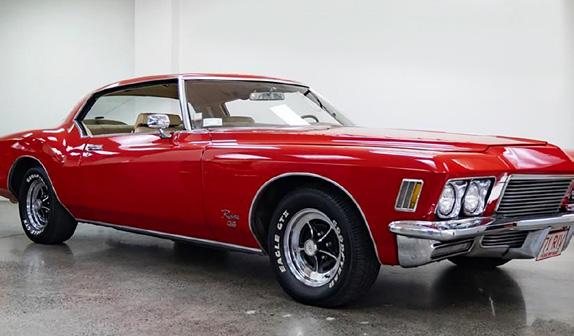
recommended package, which is similar to what it has now.
The Waikato business currently pays $4,319 plus GST per month to list 75 cars. Trade Me has suggested it shifts to a standard 75 plan from July that would set it back $6,700 plus GST a month.
“Even if we went to its new lowest plan – lite – with 75 cars then we’re looking at paying $4,500 plus GST a month,” adds Goodrick. “Instead, we’re going to cut that back to 50 cars, which will cost us $3,500 plus GST per month.

“We can’t afford to have a 75- car listing option and have to cut back. It means we can only list 50 new and used cars, and we will have to choose which ones to list on Trade Me.”
Goodrick can’t see any added value in the new packages being offered and felt the same way last year when Rosetown’s monthly spend with Trade Me jumped from $2,599 plus GST a month to $4,319 plus GST.
“You ask them what they have done that requires increases at
these levels and they can’t give you a solid answer.
“The last time it nearly doubled in price. Now it’s another 30-odd per cent if we go with Trade Me’s recommendation. The automotive industry isn’t in a strong place at the moment and you have Trade Me Motors wanting to increase its prices for what we consider is no additional benefit.”
Rosetown Motor Group is considering making greater use of other listings platforms, including Autoport and Auto Trader, radio and newspaper advertising, and its own website.
This is despite Trade Me remaining the biggest marketplace, and Goodrick admits dealerships like his will have to decide if reducing their spend with the platform and using it elsewhere is worthwhile.
“Unless big dealer groups that have got more power pull away and cut their listings – not necessarily disappear, but enough to make Trade Me look at what
[continued on page 6]

www.autofile.co.nz 5
t news
Andrew Farrow, left, of Eyrewell Forest Motor Company, is surprised there’s no Buick category on Trade Me
they’re offering – it’s hard to see things changing.
“However, this would be the most amount of angst I’ve seen on social media with dealers being irate over ongoing price increases.”
Goodrick disagrees with Trade Me only offering discounts to groups with multiple branches and says small dealers are hurting as much as larger operators when it comes to how much profit is made on vehicles sold.
INDUSTRY CONCERNS
Some dealers on social media claim to have filed complaints with the Commerce Commission about Trade Me and the Imported Motor Vehicle Industry Association (VIA) has also contacted the regulator.
Greig Epps, VIA’s chief executive, says while the association can’t get involved in discussing pricing levels, it can speak up about the perceived unfairness in the way Trade Me has approached its increases.
He adds one of the main points of concern is that the changes haven’t been explained or justified well enough to the industry.
“There have been price increases almost annually for a lot of businesses,” Epps told Autofile. “This latest round has been coupled with changes in the service offering and that’s made people feel like they’re getting less but paying more.
“We did a survey of our members who were all indicating they have had price rises over the past several years. It varied depending on the package or size of business, but most of the rises were double-digit almost every year.”
Trade Me Motors was named as the primary listing space for 92 per cent of respondents. The same proportion felt there was little in the way of viable alternatives to the site they use the most for online advertising.
Epps notes while the survey had a small number of responses, these were reflective of commentary by dealers on social-media platforms and in direct messages to VIA from members.
As a result, the association took the concerns raised by members

to the Commerce Commission to understand its view of the situation.
Epps says the regulator doesn’t see high pricing or price rises by a dominant market player as inherently creating a competition issue.
However, it would be concerned if there was behaviour that affects consumers by preventing other companies from coming into the market and providing competition.
“VIA itself can’t reach out to a service provider for its members and talk about pricing because that could run the risk of the Commerce Commission saying we’re being anticompetitive by leveraging a large group of members and customers to try to influence them,” clarifies Epps.
says it’s her understanding that prices for listings have increased significantly, but there may have been little in system or service delivery improvements as a result of the higher prices.
“It has got to the point that the frustration is focused more about the lack of alternative offering,” she adds.
“Trade Me has a monopoly and that alone is disappointing for industry. There is an awareness this behaviour wouldn’t be a problem with more competition in the market.

“I think it’s fair to say that if a new entrant was to enter the market, it would likely get more support now from industry upfront due to the extent of frustration.”
to apples with the introduction of new packages and the retirement of super features,” explains Fuller.
“With the removal of super features, and the bundling of features that support promotions, branding, finance and digital tooling, a new pricing structure needed to be established.
“The price increases are based on how prominent dealers would like their listings and also what additional features they would like, so it’s different depending on these variables.”
As part of the updates, the company followed a set of principles – choice, simplicity and fairness – to “preserve the greatest value, clarity and fairness amongst dealers”.
“We want to make sure our dealers have a choice, and can pick the package that best suits their desire for prominence, functionality and budget. We want to recognise size and spend with Trade Me. If you pay more, you get more.”
Despite discontent from the industry, the company is standing by its revamped offerings and says they offer value for consumers and car dealers, who in turn gain access to the “largest car-buying audience in New Zealand”.
It also notes that like many businesses, Trade Me is experiencing the impact of the current economic environment but continues to invest in its operations.
“We have informed our members of the conversation we’ve had with the commission and indicated if there’s any evidence members have of anti-competitive behaviour, then the commission is open to hearing about it.
“Beyond that, the most we can do is keep an eye on what’s happening and talk to the regulator on behalf of our members if they feel things get worse.”
Members of the Motor Industry Association and their retail partners are also “less than pleased” with Trade Me Motors’ price rises.
Chief executive Aimee Wiley
PRICING RESTRUCTURE
Jayme Fuller, head of Trade Me Motors, says the company regularly reviews its packages, taking into consideration new products it has introduced and the needs and wants of its customers.
She told Autofile the changes being introduced from July are based on the prominence of listings being high on the list of feedback it has received from industry and adds market response on the end of super features has been positive.
“The comparison from prior pricing to new pricing is not apples
“We hate to see any of our customers go,” says Fuller. “However, we believe these new packages still offer significant value when selling vehicles on our leading motors classifieds website.
“The industry talk isn’t new. And now dealers will have more choice than ever with the likes of Auto Trader, Only Cars, Auction Online, AutoFlip and others.”
Responding to comments from dealers about a perceived lack of support from Trade Me, she explains the motors account management team is motivated to help car companies improve their listing quality by providing advice on best practices. “However, not every package includes account management support, but that is not new.”
6 www.autofile.co.nz
[continued from page 5] news
Aaron Goodrick, of Rosetown Motor Group
Elliot Feringa, of Select Autos Tauranga
GET COVERED WITH PROTECTA

As an insurer that has been recognised with an Outstanding Value Car Insurance product, Protecta also o ers the flexibility to customise Mechanical Breakdown Insurance to best suit the needs of your customers and their cars.
With comprehensive cover, including a range of optional benefits, have confidence in tailormade solutions that protect against sudden or unforeseen mechanical and electrical failures.
dealers@protecta.co.nz | 0800 776 832 www.protecta.co.nz


news Ministers revoke credit rules
The Financial Services Federation (FSF) has welcomed an overhaul of lending laws announced last month describing them as a “return to common sense”.
Amendments to the Credit Contracts and Consumer Finance Act (CCCFA) were unveiled by Andrew Bayly, Minister of Commerce and Consumer Affairs, and Chris Bishop, Minister of Housing, on April 21.
Lyn McMorran, the FSF’s executive director, says revoking prescriptive affordability assessment regulations will make obtaining credit for all purposes easier for consumers.
She adds: “We have been fully supportive of some changes to the CCCFA, such as defining a high-cost loan, and placing limits around the amount that can be charged in interest and fees under such contracts.
“However, affordability regulations have required lenders to examine borrowers’ expenditure to such a granular level that responsible lenders were often unable to assist consumers in need of access to finance. They effectively treated every borrower as being in

vulnerable circumstances even when they weren’t.”
The FSF reports there has been a significant increase in lenders declining applications from people who they would have been able to assist before the affordability regulations were introduced in December 2021.
“This has been concerning as borrowers’ needs haven’t disappeared just because a lender is unable to assist them,” says McMorran.
Borrowers’ needs haven’t disappeared just because a lender is unable to assist them
–
Lyn McMorran
“For consumers who were still able to demonstrate they could meet the onerous affordability criteria, the process to access credit was time-consuming and questioning how they spend their money has been intrusive.”

The federation agrees with Bayly that the alternative for these people is seeking credit from loan sharks.
The government says finance providers will be able to use discretion to investigate if prospective borrowers’ assets or inheritances could affect repayments.
The proposals also mean lenders will be able to decide whether they need to see applicants’ recent transactions
and check all income sources.
The FSF is confident the changes will not open the floodgates to irresponsible lending. This is because the CCCFA still requires lenders to not lend to people who cannot afford to meet repayments without substantial hardship. There are still penalties breaching this rule.
“We are revoking 11 pages of overly prescriptive affordability regulations introduced by the last government,” says Bayly.
“When introduced into the CCCFA in December 2021, they threw a bucket of cold ice over banks and financial providers by prescribing minimum steps to assess affordability.”
He adds it has become difficult for people to borrow $500 – for example, to repair their vehicles – forcing them to go to highinterest lenders.
However, Labour has warned the changes are likely to put lenders at greater risk from loan sharks and unaffordable debt.
The previous government relaxed the CCCFA rules in May 2023 and July 2022 after conceding the changes it made in December 2021 resulted in “unintended impacts”.
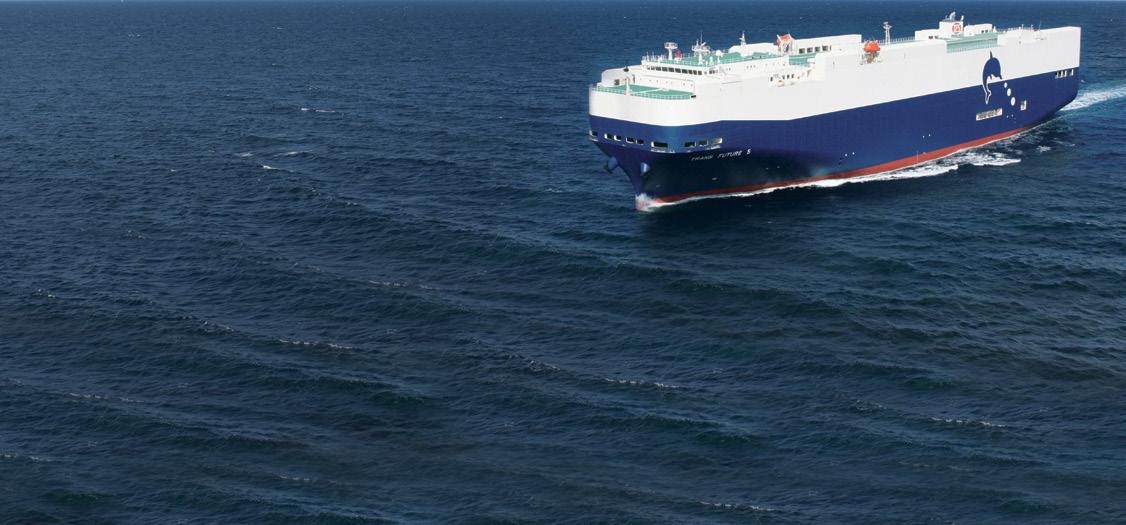

8 www.autofile.co.nz
Contact: Adam Stone adam.stone@toyofujinz.co.nz www.toyofujinz.co.nz FROM JAPAN TO NEW ZEALAND ON TIME, EVERY TIME T/S = Tranship to next available TFS vessel * TF5 and Dream Jasmine dates dependant on delays in Australian ports
JAPAN NEW ZEALAND Moji Osaka Nagoya Yokohama Auckland Lyttelton Wellington Nelson Trans Future 6 150 22 Apr 23 Apr 27 Apr 17 May 19 May 24 May Trans Future 5 153 5 May 7 May 11 May 30 May* TBA* TBA* TBA* Dream Jasmine 34 17 May 21 May 23 May 25 May 7 Jun* TBA* TBA* TBA* Trans Future 7 151 20 May 21 May 25 May 13 Jun TOYOFUJI SHIPPING SCHEDULE
Toyofuji vessels Voyage
Andrew Bayly










www.autofile.co.nz 9
Support for universal charges
Land-transport policies face industry scrutiny
The automotive industry’s three lead organisations have backed the government’s idea that all light vehicles shift to road-user charges (RUC).
More information about the proposal is outlined in the draft government policy statement (GPS) on land transport 2024-34.
When adopted, the document will replace what the previous administration sought feedback on during August last year.
Officials are now considering submissions received on the GPS before providing advice to Simeon Brown, the Minister of Transport, on the final policy statement.
Finalising the GPS is one of 36 priorities the government aims to achieve by June 30 and it was listed in a threemonth action plan released by the prime minister on April 2.
Part of the overhaul will reform how revenue is raised for the National Land Transport Fund (NLTF).
The first stage is already under way with owners of light electric vehicles (EVs) having to now pay RUC.
The next steps include moving all road vehicles from fuel-excise duty to RUC, “which is a fairer way of charging for road use based on weight and distance”, states the draft GPS.

Tolling legislation will be overhauled and time-of-use charging allowed on the most congested parts of New Zealand’s network.
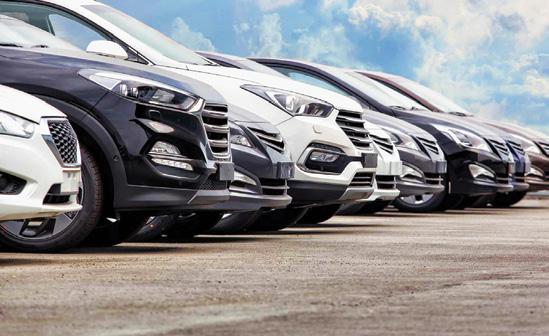
Submit two downloadable forms and simply send to us for review.
Hear back from our team about finance in as little as 24 hours.
Our partnerships give us the ability to offer superb lending rates.
Autobridge is New Zealand based and covers the country, so we are never far away when you need us.
The idea for RUC to be applied to all vehicles has been supported by the Motor Industry Association (MIA), Motor Trade Association (MTA) and Imported Motor Vehicle Industry Association (VIA).
Aimee Wiley, chief executive officer of the MIA, notes the value of fuel consumption as a proxy for road usage is rapidly diminishing.
Her organisation supports switching to universal RUC to address inequities and negative impacts the introduction of such charges is having on electric cars, especially plug-in hybrids (PHEVs).
However, the MIA cautions that introducing electronic RUC (e-RUC) across the entire fleet, which has been mooted, “would be a monumental and challenging task, which would take several years”.
It suggests it may be better to start the transition to e-RUC with imports.
Wiley says: “Rolling out the existing RUC system across the entire fleet may be achievable in a shorter timeframe although it would need to be modified to permit smaller distances to be purchased by those with limited financial means.
“Disproportionately high administration fees are also a disadvantage, which might encourage non-compliance especially for people who cannot afford to buy in bulk. More efficient
ways to manage this should be identified under the GPS.”
The MIA would like to see an industry working group set up to help design and analyse a universal RUC scheme.
“The GPS also notes the NZTA will be required to consider alternative funding and financing arrangements for all new infrastructure projects, such as tolling,” adds
“The MIA suggests one of the principles for tolling to be enshrined in legislation is that a toll only remains in force until the capital cost of the road has been recovered.”
The MTA has “commended” the proposal to move towards universal RUC as a more equitable tool for road-use charging, “which will confront the reality of increasing fuel efficiency resulting in less revenue on a per-kilometre basis”.
James McDowall, head of advocacy, adds: “Without a clear timeline for mechanisms such as universal RUC or time-of-use charging, it’s difficult to provide fulsome comment on the longterm use of these sources of revenue.”
The MTA backs rolling out an e-RUC system before or as part of the launch of universal charges, and believes it’s economically sound for the government to look at alternative funding mechanisms for land transport, particularly beyond straight taxation.
Kit Wilkerson, VIA’s head of policy and strategy, says: “The move towards a more equitable RUC system, as highlighted in the GPS, is welcomed.
“We are developing a strategy and plan for automated universal RUC, which – aside from ensuring fairness – incorporates telematics and emergency call-like functionalities.
“This innovation exemplifies VIA’s readiness to contribute to achieving value for money in the land-transport infrastructure.”
10 www.autofile.co.nz
[continued on page 12] news NZ
BASED
VEHICLE IMPORT FINANCE AT COMPETITIVE INTEREST RATES
09 320 5646 COMPETITIVE
www.autobridge.co.nz
INTEREST RATES & FEES
w EFFICIENT
EASY
SERVICE
APPLICATION
ENQUIRE NOW ABOUT TRADE FINANCE FOR YOUR BUSINESS
The government is considering submissions made for the draft GPS for land transport

smiling drive away
Here at NZ’s one-stop-shop for vehicle loans, our experienced lending team are on the job seven days a week to bring you fast and secure approvals. With a comprehensive range of multi-tiered lending options at competitive market rates, we’re ready to roll.
Applying is simple, and we’re here to help. Let’s get your customers on the road.
www.autofile.co.nz 11 Lending criteria, fees, terms and conditions apply.
0800 003 111 | dealersupport@avantifinance.co.nz avantifinance.co.nz | brandedfinancial.co.nz
Government officials say technology will be a “critical enabler” of reforms outlined in the GPS and legislative changes will be required to achieve them.
While New Zealand’s infrastructure deficit has grown over time due to the fleet’s growing fuel efficiency and more EVs being on our roads, there are other reasons for this.
The transport sector is facing cost rises because paying for maintenance and infrastructure is becoming more challenging via traditional funding models.
The current system is based on a pay-as-you-go model whereby revenue is spent as it’s raised with limited access to long-term financing. Consenting and property acquisition has become more challenging, creating added-on costs and delays.
Funding for the NLTF between 2024/25 and 2027/28 will come primarily from fuel-excise duty, RUC, motor-vehicle registration (MVR), licensing fees, crown
funding, loans and some contributions from other sources, such as tolling.
The GPS points out the MVR’s annual licensing fee hasn’t increased since 1994. Inflation since then has halved the real value of its contribution.
This is why the government wants to increase MVR by $25 in January 2025 and by a further $25 in January 2026.
In addition, it is planning to return to the previous practice of
regular fuel duty and RUC rises from January 2027. It’s assuming a jump of 12 cents per litre in January 2027, a further six cents in January 2028 and a four-cent rise from January 2029.
However, these increases are insufficient to fully replace funding top-ups from the government over the first three years.
“We are initiating policy work to determine tools required to provide a sustainable outlook,” states the GPS. “This is likely to include time-of-use charging and the transition of all vehicles to RUC.”
SAFETY OF FLEET
The government is aiming to improve road safety during the GPS’ timeframe with reforms targeted towards the highest contributing factors in fatal crashes.
It will review the regulatory
system so the fleet’s safety performance is better managed, cut red tape and ensure New Zealand’s rules are fit for purpose. When it comes to safety, the MTA is repeating its call to increase the frequency of warrants of fitness (WOFs) for vehicles aged more than 15 years from 12 to six months.
Under the present regime, vehicles up to 24 years old are required to undergo this “essential safety check” just annually because the cut-off for six-month warrants is set at a fixed date of manufacture, that’s to say January 1, 2000.
“This means vehicles continue to get older, but at no point switch to six-month warrants,” says McDowall, of the MTA. “This has created an ever-increasing window for having potentially unsafe vehicles on our roads.”
More than half of vehicles over 15 years old fail their WOFs first time and if the regulation remains as it is, these cars will simply get older and the problem worsen.
To address this, the MTA suggests a fixed age of 15 years for six-monthly warrants instead of using the year of manufacture.
McDowall says: “The issue of newer versus older cars being given the same testing regime despite significant technological differences remains complex.
“The MTA questions whether
Call to boost sales of electric cars
The MTA says funding raised from time-of-use charging schemes could be used to incentivise the uptake of low and zero-emissions cars.
The idea is suggested in its submission on the draft GPS, which outlines the coalition’s plans to invest in land transport over the next decade.
Proposals in the document include amending tolling legislation to allow for timeof-use charging on our most congested roads.
“With new fees to deal with congestion and funding, people need efficient and reliable options available should they choose to limit or change their driving behaviour,” James
McDowall, head of advocacy, says in the MTA’s submission.
“Under the assumption funds raised through regional time-of-use charging schemes will be for councils to utilise for local-transport projects, we encourage the government to enable councils to have some flexibility. For example, being able to provide local incentives for the purchase of low and or zero-emissions vehicles.
“This could be an opportunity for councils that wish to better meet climate goals by continuing the momentum of uptake for such vehicles with a vastly different funding model to the clean car discount, which the MTA campaigned against.”
12 www.autofile.co.nz
[continued from page 10] Contact: Simon James 027 239 0253 SimonJ@questinsurance.co.nz Mechanical Breakdown Insurance Comprehensive Motor Vehicle Insurance Guaranteed Asset Protection Insurance Mechanical Breakdown Insurance EV & Hybrid option available Uber & Taxi cover available Credit Contract Indemnity Insurance Our strength comes from knowing our customers’ needs, understanding and fulfilling them news Vehicle kilometres travelled versus fuel consumption Vehicle Kilometres Travelled vs. fuel consumption 0 10 20 30 40 50 60 70 0.0 0.5 1 0 1.5 2.0 2.5 3.0 3.5 2024 2026 2028 2030 2032 2034 2036 2038 2040 P e tr o l VK T ( b illi on k m ) P e tr o b illi on li tr e s ) Litres of fuel Total VKT (km) Total petrol consumption is forecast to decline in New Zealand, despite a continuing increase in road-travel distances, due to an increase in the fuel efficiency of vehicles and the shift to electric cars. Source: MoT / NLTF revenue model
the vehicle inspection requirements manual is fit for purpose. At some stage, a conversation around what initiatives could be undertaken to renew the ageing fleet should happen.
“With our member base playing a significant role in testing, we wish to lead the conversation around ensuring the WOF regime is fit for purpose.”
FUNDING FROM ACC
The MIA supports ACC contributing towards making our roads safer citing the Ride Forever programme, which has demonstrated benefits for participants.
“Perhaps consideration could be given to ACC funding the installation of alcohol interlocks to a wider number of drinkdrive offenders other than those sentenced to fit one,” says Wiley.
“These devices are as close to a silver bullet for drink-driving as it’s possible to get being virtually impossible to circumvent or avoid triggering an alert to the
equipment provider.
“We note discussion around increasing financial penalties and demerits. These generally require roadside enforcement or multi-function enforcement cameras, which so far have only been trialled in New Zealand.
“A large number of fatal and serious crashes due to noncompliance occur on rural roads where police resources are spread thin so there needs to be a reality check around how much difference increasing penalties will make in such a sparsely populated country.

A conversation around what initiatives could be undertaken to renew the ageing fleet should happen
– James McDowall, MTA
“Installing median or roadside barriers is, however, a proven safety intervention, but the NZTA has



fallen well short of its own targets.
“The GPS does not set targets in relation to the percentage of the statehighway network that should be upgraded to have barriers installed. We suggest this should be a specific target.”
The MIA supports increased road maintenance and resilience, and establishing “activity classes” to prevent potholes on state highways and local roads.
It highlights there has been a “noticeable decline” in the network’s condition. In addition to safety risks, potholes damage cars. This imposes costs on owners through repairs,
insurance costs and temporary loss of use of vehicles.
Wiley flags up the proposal in the GPS to hike the annual MVR licensing fee by $25 in 2025 and and by the same amount one year later.
“For an average car travelling a typical annual mileage of 12,000km, $25 is approximate to an annual four cent per-litre increase in petrol tax,” she says.
“The end result is the same for vehicle owners although petrol tax is generally more equitable as those who travel higher mileages contribute more, whereas a flat licence-fee increase penalises low and fixed-income earners who limit their travel.
“The proposed increase in petrol tax of 12 cents per litre from January 2027 is substantial and unprecedented, and appears to be a catch-up due to the failure to have smaller incremental annual increases in intervening years.
“This is likely to be far more unpopular with the public than a

www.autofile.co.nz 13 news
If you’re importing a vehicle, it should be with New Zealand’s number-one elite vehicle importer. With over 30 years’ experience in the industry SBL is tried, proven, trusted and here to stay. Our user-friendly, bespoke Japanese auction website has been developed and customised to meet the needs of our clients. Call us now and find out what everybody’s talking about. Ph. 03 377 6578 www.sbltd.co.nz t [continued on page 14]
three or four cent per-litre increase per annum.”
USED IMPORTS’ DYNAMICS
The draft GPS’ emphasis on increased road maintenance and resilience is crucial stresses VIA, especially given the escalating impacts of climate change.
“VIA is particularly supportive of initiatives aimed at improving road safety,” says Wilkerson. “We have devoted significant resources to understanding the primary causes of road harm.
As for reducing emissions and environmental sustainability, VIA recognises the importance of accelerating decarbonisation efforts in transport.
“We are actively participating in discussions around the second emissions reduction plan and support expanding the EV charging network.
“However, we urge caution in interpreting forecasts on the decrease in petrol consumption without considering the increase in

The MTA has suggested a fixed age of 15 years for six-monthly WOFs instead of using the year of
vehicle mass and power, which has counteracted efficiency gains in other jurisdictions.
“New Zealand’s approach should consider the unique dynamics of used imports, which have demonstrated potential for real carbon-dioxide reductions through decreased vehicle mass since the implementation of the clean car standard.
“We acknowledge the government’s efforts to address congestion through reforming tolling legislation and introducing time-of-use charging. VIA believes charging can be effective in a comprehensive strategy to mitigate congestion issues.
SUBSCRIBE TO AUTOFILE MAGAZINE

“Additionally, focus on restoring the credibility of the emissions trading scheme is essential for ensuring all polluters bear a fair share of the environmental costs of their activities.”
Wilkerson highlights the government’s proposed criteria for investing in pedestrian and cycling infrastructure, which may overlook the need to improve safety perceptions and encourage a more diverse transport system.
“A forward-looking approach that builds infrastructure in anticipation of increased use, rather than in reaction to it, will be crucial for fostering sustainable urban mobility.”
WHAT THE FUTURE HOLDS
The final version of the GPS for land transport is scheduled to take effect on July 1. It will be in place for six years or until it’s renewed, which is likely to happen in three years’ time.
Policies in the GPS mark a big shift back towards roading. Its two centrepieces are a greater focus on road maintenance – pothole repair funds and restarting the last National government’s roads of national significance programme with 15 set to be built.
The draft GPS doesn’t put a dollar figure on new roads. NZTA costings show they could cost twice as much as National budgeted for before being elected, leaving it about $24 billion short.
Simeon Brown, the Minister of Transport, has seen multiple pieces of advice on costings and the transport agency will assess projects before looking for privatesector investment.
The GPS tells the NZTA how much money should be spent in different areas of the transport system, called “activity classes”.
Brown has created two new
classes for pothole prevention. One is for up to $2.3b on pothole maintenance on state highways, the other will see about $2.5b spent on fixing up local roads.
National has killed GPS funding for inter-regional rail, which could mean an end to the Te Huia line between Hamilton and Auckland.
It has also axed funding for coastal shipping, which had been given up to $20m a year to encourage people to shift freight by water rather than truck.
Funding for public transport has been slashed. Labour planned to spend up to $3.2b on such infrastructure over the next three years, but this has been cut by nearly $1b.
The pot for council subsidies to public transport has been reduced, which could result in fare hikes.
Brown says: “Over the next three years, our investment of around $7b per year prioritises economic growth and productivity, increased maintenance and resilience, safety and value for money.
“It balances the need for investing in new projects while ensuring our transport system is maintained to a high standard.”
Ensuring investment in transport is value for money and delivers better outcomes is a key focus of the GPS.
“The government will appoint independent members to the road efficiency group,” adds Brown.
“It will refocus efforts on finding efficiencies in road maintenance, standardising maintenance protocols, reducing expenditure on temporary traffic management and reviewing maintenance contracts.
“I expect the NZTA to consider different ways of funding and delivering major transport investments.
“This will likely include publicprivate partnerships, increased use of tolling, ‘build, own, operate, transfer’ equity-finance schemes, and value capture to generate additional revenue and deliver infrastructure more efficiently.”
Alongside the draft GPS, the government is signalling several system reforms including shifting to a 10-year national land-transport programme.
14 www.autofile.co.nz [continued from page 13] news
For $78 plus GST, you will receive 12 issues a year full of need-to-know news covering New Zealand’s car industry and connected sectors. THE TRUSTED VOICE OF THE NZ AUTO INDUSTRY FOR NEARLY 40 YEARS
Just visit autofile.co.nz/subscribe to sign up.
the
safety
manufacture to help improve
fleet’s
Classifieds

coming soon w w w . o n l y c a r s . c o . n z w w w . o n l y c a r s . c o . n z
JOIN THE REVOLUTION
model as an alternative challenger brand to the main player in the market.
Industry movers
TODD FULLER has become general manager of the newly formed classifieds site Only Cars.
He was previously general manager of AdTorque Edge and had a long career as head of automotive at the NZ Herald for more than 30 years.

Fuller says: “It’s our vision to create a new classified model as a challenger brand to the main player in the market, providing a unique proposition to industry leaders.”
MARTIN BERRY, a global financial services executive, has resigned as a director of Turners Automotive Group.
He joined the company as a non-executive director in August 2018. However, his commitments as group chairman of Gong Cha Global, a tea-shop brand with more than 1,600 stores worldwide, have increased over the past year.

Being based in Singapore has made it difficult to dedicate the time he would like to give to Turners.
GRANT WOOLFORD and GEOFF KENNY have been confirmed for third and fifth terms respectively on MTF Finance’s board.
With more than 30 years’ experience in the motorbike industry, Woolford has worked his way up from apprentice to business owner.
He has been an MTF board member since 2018 and he is managing director of the Cyclespot Group.
Woolford holds board roles at the Motor Trade Association, where he chairs the finance and risk committee, and Auxo.


Kenny has some three decades’ experience in the vehicle and finance industries. As a franchise owner, he has a deep understanding of MTF’s business model, history and customers.
Representing a point of view from the day-to-day operations, he has been involved in introducing new products, company growth and increased profits.
SIMON BRIDGES , former Minister of Transport, has become the NZTA’s new chairperson on a three-year term.
He had replaced Cassandra Crowley, who held the position in an acting role since December following the resignation of Paul Reynolds.

Bridges, pictured, had a legal career before being elected to parliament in 2008 as National’s MP for Tauranga.
He held that seat until retiring from politics in 2022. Later that year, he was appointed chief executive officer of Auckland Business Chamber.
During his political career, Bridges’ ministerial portfolios included transport, economic development and communications.
Simeon Brown, Minister of Transport, says: “He will have a strong focus on delivery and outcomes, and ensure the NZTA is working to implement the government policy statement on land transport.”
Of Crowley, Brown adds: “Her strong leadership, advice and support have been invaluable during this transitional period.”
Majority shareholder takes on top position
David Sena has become chief executive officer of 2 Cheap Cars with Paul Millward resigning from the position.
Company chairman Michael Stiassny says it was logical Sena would eventually step into the role after Sena and his family trust increased its holding to about 76 per cent in 2023.
That followed approval of the transaction by shareholders at the company’s annual meeting in September last year.
Millward joined the company in January 2023 and in less than 18 months “fundamentally reset” its foundations.
Stiassny adds: “I cannot overstate the contribution Paul has made.


“David is deeply invested in this business, seeing the share price perform and dividends delivered,” says Stiassny.
“He has already played a vital role in transforming the business and increasing profitability through his focus on operations.”
“Under his leadership, the business has achieved record profits, reinstated dividend payments and was 2023’s top performer on the NZX. These are phenomenal results, even more so because it was his first CEO role.
“Paul has a great leadership career ahead of him and I have no doubt he will excel in the future. He leaves with our sincere thanks and best wishes.”
In early March, 2 Cheap Cars revised its guidance for net profit after tax for 2023/24 to between $6.3 million and $6.5m – down from $6.8m – because of exchange-rate variances in the preceding few months.
Rule relief for importers
The Imported Motor Vehicle Industry Association (VIA) has welcomed a lastminute change to the emissions rule.
It means used light vehicles will not be required to “enter into service” within four months of being border-inspected under the revised Land Transport Rule: Vehicle Exhaust Emissions 2007.
“This amendment relieves a significant area of stress for the industry, which faced uncertainty in the treatment of imports,” says Greig Epps, VIA’s chief executive.
“While the process was longer than we hoped, the outcome was a testament to what we can achieve through persistence and collaborative dialogue with the government.”
The policy shift was announced
on April 15 by Simeon Brown, Minister of Transport, after changes to the rule were approved a few days before last year’s general election.
“Left unchanged, this error would have affected around 15,000 vehicles and imposed unnecessary registration costs of around $2 million per year that would have increased retail prices,” says Brown.
“This is a small change, but one that will benefit firms and people importing and purchasing used vehicles.”
All used light vehicles crossing the border before April 30 had to meet the Euro 4 standard or its equivalents. They must now comply with Euro 5 and, from July 2028, Euro 6d.
Visit www.autofile.co.nz for more information.
16 www.autofile.co.nz
news
David Sena
Paul Millward
TO FEATURE IN INDUSTRY MOVERS EMAIL EDITOR@AUTOFILE.CO.NZ
Geoff Kenny
Grant Woolford
Car vessel powered by wind
If it’s plain sailing ahead, vehicles could be transported around the world on-board a full-size roll-on, roll-off creating up to 90 per cent fewer emissions compared to other vessels.
Norway-based Wallenius Wilhelmsen is aiming for the Orcelle Wind to have capacity for 7,000 cars, and to be able to carry heavy machinery and breakbulk cargo.
The ship comes in at 220 metres long and its height to the top of the wing sails will be about 100m depending on their ultimate design.
Essentially, the advanced computer-controlled sails are vertically mounted aircraft wings. They will generate more force, and be more robust and easier to control than conventional alternatives.
The Orcelle Wind will achieve roughly 12 knots under wind power alone, but will have an auxiliary propulsion system for higher speeds, port navigation and adverse weather.
The idea was first floated in 2005 at the World Expo in Japan and set down a marker the shipping company has since been working towards.
Since then, making the ro-ro a reality is far from being “just” a technical challenge. It also requires new thinking on how to manage the transport of vehicles “from factories to dealers on the other side of the world”.
The Orcelle Wind’s actual emissions reduction will depend on a range of factors, such as prevailing conditions and the route taken. Testing on the vessel is slated for later in 2024 with a view on it entering service a few years from now.
SKIRTING AROUND ISSUE
Hyundai and Kia have unveiled their “active air skirt” (AAS) technology to minimise aerodynamic resistance generated during high-speed driving, effectively improving the range and stability of electric vehicles (EVs).
AAS controls the flow of air


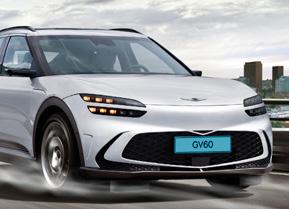
entering through the lower part of the bumper. It effectively controls turbulence generated around the wheels by operating variably according to how fast a car is being driven at high speed.
In the electric era, competition to secure better single-charge ranges has become fierce, making aerodynamics even more important.
In response, the two manufacturers have been exploring measures to reduce the co-efficient of drag (Cd) – the resistance of air acting in the opposite direction of the vehicle’s motion.
AAS is installed between the front bumper and front wheels. It’s hidden during normal operation, but operates at speeds of more than 80kph when aerodynamic resistance becomes greater than the rolling resistance and is stored again at 70kph.
AAS only covers the front part of the tyres without completely covering the front and is related to the characteristics of Hyundai’s E-GMP platform for EVs.
The system can operate at more than 200kph. This is possible thanks to applying rubber material on the lower part, which reduces the risk of external objects


damaging the car at high speeds and also ensures durability.
Hyundai and Kia have tested and reduced the Cd by 0.008, improving drag by 2.8 per cent, by installing AAS in the Genesis GV60. This is a figure that can expect a range improvement of about 6km.
The technology is expected to have a greater effect on models such as SUVs on which it’s trickier to improve aerodynamic performance.
Meanwhile, Hyundai Motor and Kia are applying various technologies, such as rear spoilers, active air flaps, wheel air curtains, wheel-gap reducers and separation traps, to vehicles to secure competitive drag co-efficients.
The Ioniq 6, which incorporates these technologies, has achieved a global-leading Cd of 0.21.
WORKING WITH GOOGLE Polestar, the Swedish all-electric marque, is continuing its strategic relationship with Google.
The latest innovations in its cars with Google built in are now being rolled out, including features available in the Polestar 2.
Thomas Ingenlath, Polestar’s chief executive officer, says: “Since launching the Polestar 2 more than
three years ago, we’ve seen the Android Automotive OS ecosystem expand with a long list of new apps and functionalities being introduced.
“Our strong relationship continues to deliver new features for owners, and they will enrich the Polestar 3 and 4 this year as well.”
Google is introducing a feature that enables users to plan trips on Google Maps on their Android or iOS devices and simply send the planned route to Google Maps built into their Polestar 2.
The marque has been an early adopter of in-car browsing having launched Vivaldi for the Polestar 2 in 2021.
The Chrome browser is now starting to be rolled out for this model in beta, bringing drivers a familiar and easy-to-use browsing experience while parked.
ALEXA GETS ON-BOARD
BMW says it will start using Amazon Alexa technology in some models this year.
The two companies have showcased a voice assistant based on Alexa’s AI model, which processes human language at a high level and generates sophisticated responses.
“The next generation of the BMW Intelligent Personal Assistant will soon become more powerful over the course of the year in vehicles with BMW Operating System 9,” says the marque.
Amazon is one of several large players in the vehicle voiceassistant market, which also includes Google and Cerence.
www.autofile.co.nz 17
Polestar is collaborating with Google Maps
Hyundai and Kia’s active air-skirt system will benefit EVs
technology
The Orcelle Wind is being built by Wallenius Wilhelmsen
Celebrating Sir Colin’s life
Family, friends and former colleagues from the car industry, motorsport and charities Sir Colin Giltrap supported have farewelled him.
A service to celebrate his life was held at Holy Trinity Cathedral in Parnell, Auckland, on May 1.
The founder of the Giltrap Group and philanthropist died at home on April 17, aged 84. He had been battling ill health since suffering a fall in London in 2023.
The family’s tribute, which was published online, describes Giltrap as having been a “cherished husband, father, grandfather and brother”.
He passed away “peacefully at home surrounded by family, leaving a void filled with fond memories and enduring love”.
The tribute continues: “As a family man and a great figure in the automotive world, his life was characterised by a deep commitment to his industry and community.
“His philanthropic spirit and determination brought about significant change and touched countless lives.
“His legacy of wisdom, compassion and leadership will forever inspire those he leaves behind – his devoted wife Lady Jennifer, his children Richard and Sarah, Michael and Nicola, his grandchildren Sophie, Marco and Harriette, and his sister Ngaira.
“We are deeply grateful for our time with him and will honour his memory by continuing his work.
“The Giltrap family thank those who have expressed their condolences and send heartfelt gratitude to the staff of ward 51 at Auckland Hospital for the care given to Colin.”
In lieu of flowers and gifts, the family invites people to make donations to Auckland City Mission.
Giltrap spent his lifetime in the automotive industry. He passed on the business to his sons Richard and Michael in recent years although he remained active in it.
The company started in the
Sir Colin Giltrap with his wife Lady Jennifer

1960s when Gitrap co-founded Hamilton luxury car dealership, Monaco Motors.
In the early 1970s, he bought Matamata Motors, and then a Mazda and Audi dealership in Auckland. It was in 1977 that he founded European Motor Distributors, which bought the rights for Volkswagen.
After that, the company expanded.
It has gone on to represent a host of brands in New Zealand including BMW, Bentley, RollsRoyce, Nissan, Jaguar, Toyota, MercedesBenz, Aston Martin, Lamborghini, Polestar and Lotus.
‘QUITE A GOOD HONOUR’
In 2012, Giltrap was made a Knight Companion of the Order of New Zealand for his services to motorsport and philanthropy.
At the time, he was unsure what to make of it.
“It’s quite a good honour. I didn’t realise when I first received it how much it meant, but I’m starting to slowly get used to it.
I’m just Colin. Always have been, always will be - on being knighted
In 2017, the Giltrap Group moved into new $40 million headquarters in Auckland, which won a national award from the NZ Institute of Architects.
According to the company’s website, it now has 21 dealerships and its own service centre in Auckland, European Financial Services, Sixt NZ and about 800 employees.
the worst initiative was paying huge money to get Tiger Woods here for the NZ Open,” Giltrap remarked in 2012. “It rained all the time and he didn’t perform at all.”
Of his philanthropy, he described it as “very rewarding, usually it’s great”.
INTERVIEW WITH AUTOFILE
It was rare for Giltrap to speak to the media. That said, in March 2016 he agreed to an interview with Autofile, which was published the following month. What follows is an edited version of that article.
Looking back to Giltrap’s beginnings, it all started in New Plymouth opposite his father’s tractor and machinery business.
“I was also selling cars for my dad to other dealers when I was 13 or 14. The first one I sold was a 48 Ford Mercury and we did very well out of it.
“Things could have been a lot different as my father wasn’t that keen. He loved cars too, but wanted me to go into farming. He sold out and took the whole family to Ireland. I refused to budge because I just wanted to sell cars.
“I’m a bit trepiditious about it because I’m still Colin to everybody. A few of the staff don’t know whether to call me Sir Colin or Colin, but I want to get the message around that I haven’t changed. I’m just Colin. Always have been, always will be.”
Giltrap was a patron of the McLaren Trust. He supported and mentored numerous young racing drivers. He also contributed to many sporting events and charities, including the Starship Foundation and Canterbury’s earthquake appeal.
Being a patron wasn’t always smooth sailing, however. “Probably
“I was 18 and knew what I wanted to do. It was all about cars and I couldn’t wait to sell the Jaguar 2.4, which was the greatest car around at the time.”
With his career die cast, Gitrap moved to Hamilton and founded Monaco Motors. “I just loved luxury vehicles, and we knew how to sell and buy them. I had contacts at nearly all the embassies in Wellington – a great source of top-line cars.
“I got to know a few chauffeurs. They met at functions… and I also had a scout at the airforce base in Christchurch.
“Senior American personnel were allowed one car a year. We would almost tell them what to buy – maybe a red, yellow, blue Chevrolet. You didn’t have to be high up in the embassy to get diplomatic privilege.”
Confident and determined, next
18 www.autofile.co.nz news
obituary
came buying his first dealership, Matamata Motors in 1970. “They were great times down there with Bacardi and Cokes galore. Back then with import licensing, I used to buy up companies that had one. I just knocked on their doors.”
Giltrap’s “first big break” came the following year. After moving to Auckland, he bought Coutts & Co, which imported Daimlers at the time and had a big import licence.
“That was undoubtedly my best industry buy. We had a number of franchises there including Daimler, Rover and Triumph. I then bought Shelley’s in Wellington, which had a BMW licence. Then the Peugeot franchise off Campbell Motors and that was big. I was always looking to grow.”
It was around 33 years ago that Giltrap bought Bradshaw Webb, the main Mercedes-Benz dealership for London at the time.
“It was unheard of for a Kiwi or anyone from overseas to come in like that, but I’d had a few recommendations and grabbed the franchise ahead of serious opposition. We even considered moving to London at the time.
“Anyway, we bought some properties, but eventually sold the business as it was taking up too much time and wasn’t practical.”
Blessed with an acute sense for a good deal, Giltrap invested in Skoda in 1996. Despite the brand’s negative perception, especially in the UK in the 1970s and ’80s, he could see its potential.
He described it as “fantastic”, noting younger people don’t take notice of the past. “It has terrific models and wins awards all over the world.”
It hasn’t all been plain sailing for the Giltrap Group down the years. “We had a tough time in 1986-87 during the financial crash as many people did. We’d expanded too fast and basically over-borrowed.
“Interest rates shot up to ridiculous levels. We had nothing and profits were minimal but we managed. With the help of the bank, we got through it.”
A decision by the government that had a major impact was when import-licence requirements were lifted in the early ’80s. “Suddenly

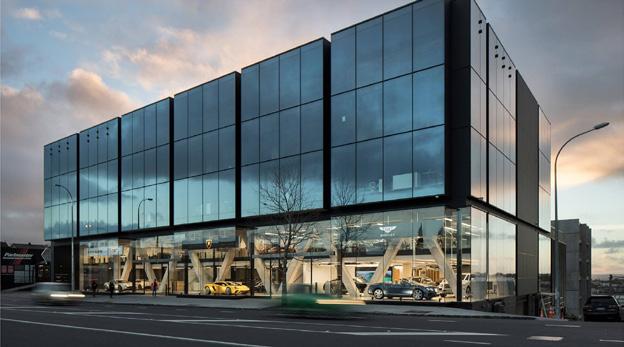
everyone could bring in cars and Japanese imports flooded the country. Premiums just disappeared, especially on hard-to-get models.
“We’re not against used imports, but it’s crazy to allow cars in that are so old. There should be an age limit on used cars coming in, maybe around seven years. From a safety and quality perspective, it’s not a great situation and the government is turning a blind eye.”
While the Giltrap Group is headed by Sir Colin, the effective chief executive officers are sons Richard and Michael – and he couldn’t be prouder.
“There was never any pressure
on them and the boys could have done what they liked.
“However, they used to come with me to the Monaco GP, aged eight or nine, and knew the drivers. They were big Ayrton Senna fans. We would take them everywhere and they got a liking for it.
“It was good because Richard did a business management course at Harvard, while Michael was a bit more of a salesman so he tended towards the retail side. He started off washing cars on the North Shore, then moved into spare parts for a while and then selling cars.”
Wife Lady Jennifer is a popular topic. “It’s been tough for her,


especially at the beginning when I was away a lot. But we went to London together – she really loves to play a round of golf there – and I couldn’t do it without her.”
Giltrap is determined not to let go of the reins quite yet. “Even now I have meetings with my sons all the time, we’re forever on the phone.”
He’s still sharply in tune with the industry, especially in terms of technology. “Electric cars are sure to be big. Within the next two years, they will have batteries approaching 500km.”
On intelligent transport and self-driving cars, he’s more sceptical. “I don’t think they’ll take off any time soon.
“Kiwis love driving and, although it would be handy from time to time, I can’t see them giving up the freedom of driving their own cars. Although five years ago, we were saying that about electric vehicles.”
Proud of his roots, Giltrap may spend three or four months of the year in London – “such a safe city with great culture” – but he will always call Aotearoa home. “I’m a Kiwi. I follow the All Blacks everywhere and know them well.”
An in-depth story on Giltrap’s achievements and more tributes can be found online at www.autofile. co.nz. Turn to page 28 to read about his involvement in, and passion for, motorsport.
www.autofile.co.nz 19
All smiles next to his 1958 Porsche Carrera 356. Photos: Giltrap Group
Giltrap North Shore in the 1970s
t obituary
Sir Colin was impressed with the Giltrap Group’s new head office in Grey Lynn, Auckland, which opened in 2017
Brand extends national reach
Amarque has been increasing its presence in New Zealand by opening more dealerships.
MG now has representation in six areas of the South Island and has added Northland to its portfolio in recent months.
Marlborough MG is led by Simon Wakelin, dealer principal, and has Sky Boskett-Barnes and Matthew Grigg as sales consultants. It is part of Mayfield Motorworld in Hutcheson Street, Blenheim, and offers new-vehicle sales, after-sales, servicing and parts.
Expanding the carmaker’s reach further south is Timaru MG, where Keryn Pow is the business manager and Pierre Guinan is sales consultant.
The two new South Island sites join the marque’s existing outlets in Nelson, Christchurch, Dunedin and Invercargill.
And Northland MG has opened in Port Road, Whangarei, on a site previously run by Mark Cromie Motor Group. It’s part of the Tristram Group, which already offers the brand’s cars at its site in Wairau Valley on Auckland’s North Shore.
Wakelin reports there has been “unprecedented interest” in MG across the Marlborough area.
Kia New Zealand has confirmed it will be launching the marque’s all-new ute here next year.
Called the Tasman, it has undergone extensive durability testing in Australia, as well as ride and handling programmes.
“The launch of any model is an exciting moment,” says Todd McDonald, managing director of Kia NZ.
“But when it’s something as uniquely antipodean as a new ute, then it’s extra special and we can’t wait to introduce it to Kiwi customers.
“We are thrilled to be expanding our portfolio with something as desirable as a ute. We’re confident it will find favour
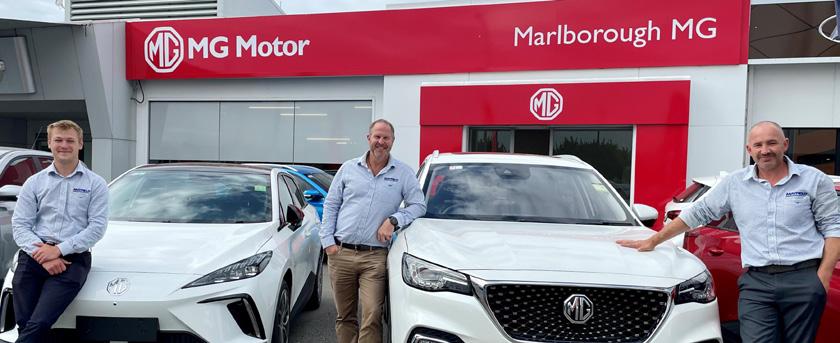

“We’re really enthusiastic about representing MG and there’s real momentum building with the brand. There are exciting times ahead.”
Timaru MG’s new-car sales take place in Theodosia Street, and the dealership has separate premises catering for service and parts.
Pow enthuses: “MG is a brand on the move and we’re thrilled to
offer the full range of new models. We are looking forward to seeing more MGs on our streets and surrounding regions.”
Bradley Antonievic, who is the dealer principal of Northland MG, says: “There is a wide selection of no and low-emissions models as well as traditional internal combustion engine vehicles, which means there’s a transport solution
Ute to expand line-up
with people who need a workhorse, but also a practical vehicle which fits the bill for weekend activities.”

McDonald adds the Tasman will be a welcome addition to the marque’s line-up and that it’s already renowned as the most Aussie Kia ever, “a quality that’s equally applicable to this country”.
He says: “It has been designed and engineered for our challenging conditions. It’s as dependable and reliable as the best working dog down on the farm.
“The Tasman will offer an attractive and viable alternative for those who demand the functionality and versatility only a true-blue ute can provide.”
The marque captured the imagination of its fans and the media with a star-studded teaser campaign in Australia in the runup to its official launch.

for almost every requirement.”
Arek Zywot, country manager of MG NZ, says: “Growth and development at a dealer level is a key part of our long-term network strategy.
“Increased accessibility to our portfolio means a larger number of potential buyers can now be able to add MG to their consideration list.”
With a backdrop celebrating sports culture, adverts hinted at its rugged capabilities and alignment with the adventurous spirit of Australasia.
Notably, the Tasman name was integrated along with a newspaper headline declaring a Kia ute was on its way.
Persistent reports indicate the utility may borrow bits and pieces from the Mohave midsize SUV, which is available in South Korea, albeit with heavily modified looks. Its features include a ladderframe construction, adjustable air suspension and a selection of automatic transmissions.
An electric version of the Tasman could come a year or two down the line.
20 www.autofile.co.nz news
The team at Marlborough MG. From left, Sky BoskettBarnes, Simon Wakelin and Matthew Grigg
Dealer principal Bradley Antonievic, third from left, with team members at Northland MG
Keryn Pow, business manager at Timaru MG, and sales consultant Pierre Guinan
The Tasman in disguise
Boosting your profile with Google
Believe it or not, there’s a common form of advertising that won’t cost you a cent, but is highly effective at driving traffic to your website and customers through your door.
We aren’t suggesting you throw on a gorilla suit and wave at people in cars as they pass your dealership. Instead, we are talking about your Google Business Profile.
Formerly known as Google My Business, this is a free marketing tool provided by the tech giant. It allows companies to control and manage the way they appear when someone uses Google’s search engine or map feature.
When a prospective customer runs a search, various results are displayed. These include a list of businesses offering services matching the user’s enquiry.
The relevant Google Business Profiles feature prominently at the top of the search results as well as in an adjacent map.
It’s more than likely you already have a Google Business Profile. However, there are a few tweaks you can make to ensure you’re getting the most out of it.
VERIFICATION PROCESS
The first thing you need to do, if you haven’t already done so, is verify
your business with Google. This will ensure its profile appears in search results and the location is marked in Google Maps.
An online search for “how to verify my business on Google” will steer you through this process or seek assistance from your marketing partner.


JAMES
HENDRY National account director AdTorque Edge NZ
If you have multiple dealerships, it’s important to verify each location separately as opposed to relying on a single group profile.
A new prospect will often want to know where, for example, their closest Toyota dealership is.
If you display your group, as opposed to the Toyota franchise profile in their results, customers may become confused or lack confidence in your ability to meet their needs and be less inclined to click on your business.
Ensure your profile is fully optimised and constantly updated
DETAILED INFORMATION
Your Google Business Profile isn’t just a way to share your address
and phone number with people already searching for your brand. It’s also a chance to reach prospects who have never heard of you.
The key to generating new business from this tool is to ensure your profile is fully optimised and constantly updated. Research has found web users are 70 per cent more likely to click on a completed Google Business Profile than one that’s not. This highlights the importance of ensuring your profile is up to date with contact and address details, current opening hours adjusted in line with public holidays and so on. It should also be optimised with a description, relevant photos and reviews.
Google uses this information to determine relevancy and proximity to the user when deciding whether to display a company in search results. Completed Google Business Profiles are 2.7 times more likely

to stand out meaning they will appear higher in a search.
CUSTOMER REVIEWS
As well as helping to optimise your Business Profile, your star rating on Google is an important factor when it comes to a client’s decision to engage with you.
Google is often a car shopper’s first point of call when deciding which company to contact, and testimonials are the best way to build trust and credibility.
My recommendation to clients is to establish post-sale and service processes whereby they SMS customers a link encouraging them to leave a review on their Google Business Profile. Prize incentives can also be a way to further drive this.
Don’t be concerned about maintaining a constant five-star rating. Google sees a mixture of positive and negative reviews as being more authentic and credible, so ranks these profiles more highly.
It doesn’t take a lot of time, effort or money to properly set up your Google Business Profile, but the rewards you will reap from it are considerable. So why not pack up that monkey suit, sort out your online profile and watch new customers come rolling in.

www.autofile.co.nz 21 DIGITAL VIDEO ADVERTISING MAXIMISE YOUR IMPACT WITH CAPTURING ATTENTION & DRIVING CONVERSIONS (09) 884 4699 info@adtorqueedge.com adtorqueedge.co.nz ADTORQUE EDGE ADTORQUE EDGE
Journey from sunlight to petrol
As we continue to explore the options and rationales for moving away from internal combustion engines (ICEs), an intriguing truth emerges and that’s all cars are solar-powered.
This assertion might initially seem like a stretch, especially for those who enjoy the roaring powertrains of fossil-fuel vehicles.
However, a deeper dive into the origins and journey of the energy propelling our cars reveals a solarpower lineage that dates back millions of years.
The energy that drives our traditional ICEs began its journey as sunlight, captured by ancient plants and animals that fed on these plants.
This biological material, through a slow and complex process, transformed into the oil reserves we exploit today.
The journey from sunlight to petrol is a long multi-stage odyssey that significantly impacts the efficiency of energy contained within.
The first step in this process is the formation of oil, a millennialong transformation of organic material into hydrocarbons. This step, while not consuming more energy, is limited by its geographical and temporal constraints rendering it, so far, a non-renewable resource.
The next phase is extraction whereby significant energy is expended to retrieve these hydrocarbons from deep within Earth.
Following extraction, the oil is transported to refineries, a process that incurs extra energy costs
and contributes to the overall carbon footprint of fossil fuels.
Refinement transforms that crude oil into petrol, diesel and other petroleum products. This step is extremely energyintensive, further reducing the fuel’s netenergy output.
 KIT WILKERSON Head of policy and strategy kit@via.org.nz
KIT WILKERSON Head of policy and strategy kit@via.org.nz
The final product then embarks on another journey, transported to markets where it’s finally made available for consumption.
When burned in our vehicles’ engines, the energy released is a fraction of what was initially captured by ancient sunlight.
Each step in this elaborate process reduces the efficiency of the original solar energy stored in fossil fuels, not to mention significant environmental impacts associated with each phase.
In stark contrast, the pathway of direct solar or wind energy, which can also be considered a derivative of solar power, to our cars is much more direct and efficient.
It involves capturing sunlight through photovoltaic cells or harnessing wind energy, which is generated by atmospheric movements caused by the uneven heating of Earth’s surface by the sun.
This energy is then converted into electricity and fed into the grid, eventually charging electric vehicles.
The conversion of sunlight to electricity and its subsequent use in powering cars involves fewer steps, and doesn’t require
the ongoing transportation of the energy-storage medium to market.
This results in higher efficiency rates than those in the fossil-fuel lifecycle and this method also significantly reduces the environmental footprint associated with powering vehicles.
Were we to compare these two options as if they were generic products newly introduced into today’s market, the contrast would be stark.
The fossil-fuel pathway would be a Rube Goldberg machine, complex and inefficient, converting ancient sunlight into usable energy at a high environmental and energetic cost.
The direct solar or wind pathway, by comparison, is a streamlined process that utilises current solar energy with far greater efficiency and minimal environmental impact. The winner of the two products would be obvious.
The origins of the oil that powers our fossil-fuel vehicles offers additional insights and interesting parallels.
It’s likely that much of the oil is derived from cyanobacteria, one of the earliest forms of life on Earth.
These microscopic organisms played a pivotal role in terraforming our planet’s atmosphere to be suitable for modern life by producing oxygen from carbon dioxide through photosynthesis.
Ironically, the oxygen-rich
atmosphere they produced led to cycles of flourishing and mass extinction among cyanobacteria populations as they were poisoned by their own waste product and the habitat loss caused by climate change – cooling – their terraforming resulted in.
This narrative of ancient cyanobacteria is eerily reflective of our current predicament with fossil fuels.
In producing energy by burning the ancient remains of these and other organisms, we are contributing to global warming. We’re effectively being poisoned and dispossessed by the byproducts of our consumption.
The cycle of life, death and environmental transformation that marked the dominant period of cyanobacteria mirrors our journey with fossil fuels, highlighting a bitingly ironic twist on our quest for energy.
When we peel back the layers of our energy-consumption habits, we find that all cars are indeed solar-powered although some pathways for getting that power to market are infinitely more efficient and sustainable than others.
The story of cyanobacteria serves as a poignant reminder of the cycles of environmental change and the consequences of overconsumption. It’s one we should take to heart.
As we navigate the challenges of energy use and climate change, perhaps it’s time to embrace more direct and efficient ways to harness the sun’s power, leaving ancient sunlight where it belongs and that’s in the past.
22 www.autofile.co.nz tech report
Advise • Advocate • Connect www.via.org.nz Imported Motor Vehicle Industry Association Advocate Advise Connect
Three models launch marque
Omoda Jaecoo, New Zealand’s newest automotive brand, was officially launched last month in Auckland.
The much-anticipated pricing for its C5 and E5, which are now available at 13 dealerships, was also revealed at the glitzy occasion.
The marque’s range starts with the C5 1.5T BX from $29,990 plus on-road costs with its EX sibling priced from $34,990.
Then there’s the C5 1.6T GT and AWD from $37,990 and $2,000 more respectively.
Starting at $47,990, the Omoda E5 BX has been positioned to have the country’s lowest recommended retail price for a battery electric vehicle.
This promotional price is lower than the standard $49,990 and $3,000 less than what it costs across the Tasman, while the E5 EX tops out the range at $54,990.
Sheldon Humphries, Omoda Jaecoo’s country manager, says the brand is dedicated to “accessibility, innovation and exceeding the expectations” of Kiwis.
He adds: “We believe our pricing will not only make premium vehicles more attainable, but will also drive a new era of value-driven experiences on our roads.
“Omoda aspires not only to offer cleaner modes of transportation to users through cutting-edge technology, but also to lead the future of intelligent green mobility.”
The E5 BX features an ecofriendly lithium iron-phosphate battery with a range of 430km and rapid charging from 30-80 per cent in 28 minutes.
The marque says the car delivers a “futuristic” motoring experience


and its dashboard design is typically electric minimalist.
Most functions are accessed through its dual 24.6-inch digital screens, both under one glass panel, while its advanced safety features include blind-spot monitoring and automatic emergency braking.
The EX variant adds powered, heated and ventilated front seats, and a heated steering wheel. It also comes with 64-colour ambient lighting, a powered tailgate and sunroof, rear privacy glass and a 360-degree surround monitor.
The fully electric compact crossover is powered by a 61kWh battery pack and has a 150kW and 340Nm motor that drives the front wheels.

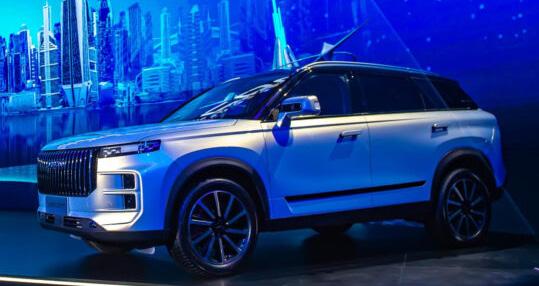
The C5 comes with a choice of engines. The turbocharged 1.5-litre produces 108kW of power and 210Nm of torque mated to a continuously variable transmission. The 1.6 GT’s outputs are 147kW and 290Nm.
Its advanced technology includes dual 10.25-inch screens and an AI voice-command system. Wireless charging, LED headlights and driver-assistance systems are standard, while the premium model adds a 360-degree surround camera and front and rear-parking sensors.
All Omoda models come with a seven-year warranty, AA roadside assistance for up to seven years and an eight-year or 60,000km

battery warranty for electric cars.
The company plans to release eight models in New Zealand over the next two years under the Omoda and Jaecoo brands, the latter of which is designed mostly for the off-road market.
The Omoda C9 PHEV and C7 PHEV are slated for launch here in late 2024 and 2025 respectively.
The brand is experiencing significant growth in 18 markets worldwide with 12,000 vehicles sold in November 2023 alone.
The Jaecoo J7 SUV will also be released this year with internal combustion and plug-in hybrid powertrains, followed by the J8 next year with the same choice of engines.

news
Guests at the Omoda Jaecoo launch at Auckland’s Viaduct Events Centre
Sheldon Humphries, Omoda Jaecoo’s country manager, at the company’s New Zealand launch last month introducing the E5
Jaecoo’s J7 SUV
The Omoda C5
The month that was... May
May 31, 1999
Dramatic law changes to retailing
Legislation with the potential to have as big an impact on New Zealand’s automotive industry as the advent of used imports was introduced to parliament.
An amendment to the Motor Vehicle Dealers’ Act was about to receive its second reading. It would then go to a select committee and was likely to be enacted in June 1999.
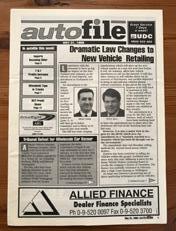
The bill had wide-ranging ramifications that would open up the newvehicle market in a way not seen here before. It would, for instance, allow distributors to sell via the internet.
The legislative changes would also allow Amway to sell direct via its network of distributors, permit parallel importers to bring in and sell new vehicles almost without restrictions, and pave the way for Daewoo to be back in business by July.
The amendment’s potential effects were huge and could see enormous changes made to the way new vehicles were retailed.
The bill was a coup for the Motor Industry Association and Daewoo, both of which had been working hard to have the amendment put in place since the distributor fell foul of licensing laws in late 1998.
May 2, 2008
SIN becomes CIN
Changes to the information notice motor-vehicle traders had to provide when selling used cars were announced by Judith Tizard, Minister of Consumer Affairs.
“After reviewing whether the current SIN regulations were meeting the needs of consumers and the industry, the government has approved changes to improve the information on the notice,” she said.

From July 1, 2008, traders needed to complete and display the new consumer information notice (CIN) when selling used cars. The CIN would replace the SIN card.
“The renaming of the SIN to the CIN highlights the fact that the information is meant for the consumer’s consideration,” explained Tizard. “The changes will also make it easier for traders to complete the form.”
The new CIN would provide clearer details to private buyers about the year a car was first registered in New Zealand on the motor-vehicle register. The cash price had to include the on-road costs and it would be easier to see if there was any security interest over the vehicle.
Another change was traders and consumers would be required to sign the CIN, which served to draw attention to the information provided to buyers.


May 31, 2006
Dodgy dealing or ignorance?
Autofile found a series of unusual circumstances when checking on a supposed registered trader selling cars – without supplier information notice (SIN) cards displayed – on a roadside in suburban Auckland.
Yes, there were cars for sale outside the man’s address, and no, he didn’t identify himself as a registered trader immediately when prospective buyers stopped to inspect the vehicles.

But he eventually did hand over a business card, which was when issues arose. The man was shown on the card to be a Motor Trade Association (MTA) member and a registered dealer.
However, a check on the register of motor-vehicle traders showed the registration expired on May 3, 2006, so technically he appeared to be a private seller and, therefore, not legally required to display SIN cards.
But the story didn’t end there. The man’s card made two claims. These were representing him as a registered trader when in fact the registration had lapsed, and holding himself out to be an MTA member when he wasn’t nor ever had been according to the association.
Steven Downs, of the MTA, said the man had been sent a letter stating he needed to stop using any reference to the association.
May 22, 2009
Industry calls for scrappage incentive
The industry had been talking for a number of years about scrappage – how to get a scheme up and running, what the criteria would be, how it would work and, more importantly, if it could be used to stimulate car sales.
The thought in many dealers’ minds was that not everyone was going to walk onto a yard after just scrapping their vehicle and be looking to purchase a replacement.
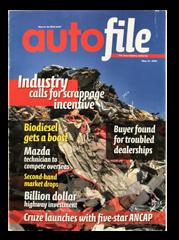
However, if the flow-on effect of the consumer chain was considered, would-be buyers could more than likely look at purchasing a secondhand vehicle. If the government investigated adopting similar schemes in other countries, New Zealanders might look at buying a new vehicle.
In Germany, sales climbed by 19 per cent in April 2009 compared to April 2008 as a trade-in plan to scrap old cars continued to encourage purchases. Sales jumped by 40 per cent in March.
Germans were taking advantage of a scheme that gave owners 2,500 euros for trading in a vehicle more than nine years old. While that scheme would be phased out by the end of the year, a similar one had been introduced in the UK.

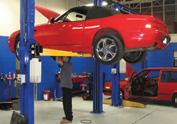

24 www.autofile.co.nz looking back
Don’t go searching for news. Let the news come to you. Subscribe now to for twice-weekly updates www.autofile.co.nz/subscribe INSIGHT

Kiwi perspective on emissions
As part of the MTA’s manifesto last year, we asked the next government to review the previously set global-leading carbon dioxide (CO2) emissions reduction targets for New Zealand.
Those targets would severely impact our automotive market because we don’t control the manufacture of vehicles in our country and, due to our size, our influence over manufacturers’ CO2 levels is very minimal.
The previous CO2 levels for 2026/27 were unrealistically set well below Australian, European and US targets, and this year we’ve seen the slowing of electric vehicle (EV) sales since the end of the clean car discount.
It’s now up to dealers to bestow the benefits of low-emissions vehicles to continue uptake from the business and private sectors.
Without EV credits, it puts upward pressure on pricing. It possibly forces companies and private buyers to hold onto their vehicles for longer, which in turn pushes the average age of our old fleet even higher.
In New Zealand, nearly 70 per cent of our fleet is six years or older. Of that, almost 50 per cent is more than 15 years of age. The older the fleet, the more environmental, health and fuel-efficiency challenges we create.
Importing low or zero-emissions vehicles is just one aspect of reducing CO2 levels in the automotive sector and it’s a good start.
The importance of keeping up the maintenance schedule, not just because of warranty compliance, is another great starting point because a regularly serviced car translates into better fuel efficiency and reduced operating costs.

Lowering our CO2 levels contributes to global efforts to combat climate change. It’s not just about us. It’s about our shared responsibility toward the planet for today and future generations.
and what better way to see the country than by motor vehicle.
On the North Island, there are some wonderful highways, such as the thermal explorer, forgotten world, twin coast discovery, volcanic loop, Pacific coast and Surf Highway 25.
By curbing CO2 emissions in new models or correctly maintaining in-service vehicles, we also improve air quality.
Cleaner air means healthier
As New Zealanders, we spend a lot of time driving such as commuting to work, doing the school run, taking children to sports, going shopping or just using the car while on holiday.
We cherish our pristine landscapes and our wonderful country from the South Island’s

Kiwis due to less respiratory sicknesses, preventing premature deaths, hospitalisations and reducing the workload of our already-stretched emergency rooms to create better quality of life for all.
Exploring is in our blood and motoring around New Zealand has become the means for our homegrown getaways. Our great journeys change with the seasons
Across Mainland we have mountain passes – Arthur’s, Lewis and Lindis – the Crown Range, Catlins, west coast scenic drive and Aoraki Mount Cook Road.
From the North Island’s top to the bottom of the South and everywhere in between, there are breathtaking road adventures and experiences that capture the essence of all that’s Kiwi.
The more you drive around this country, the more you realise we need to commit to safeguarding our natural heritage for generations to come.
And one fundamental step in this endeavour is reducing CO2 emissions from our vehicles because our natural treasures rely on us to keep doing our part and reduce our footprint.
Lowering tailpipe pollution from our fleet will help protect New Zealand’s unique flora and fauna for future generations to enjoy as they experience some of our awesome road trips, enjoy the calls of native birds, marvel at ancient kauri forests, journey along coasts or cruise one of our many great day trips.

www.autofile.co.nz 25
west coast road to the white-sand beaches of the Far North.
LARRY FALLOWFIELD Sector manager – dealers, Motor Trade Association
Natural treasures rely on us to keep doing our part and reduce our carbon footprint
Big reveals in the Big Apple
The 2025 Macan EV has made its global debut and signals a major shift in Porsche’s SUV line-up as it switches from internal combustion engines to a fully electric platform.
The all-new model, which was revealed at the New York International Auto Show, boasts a familiar design by the marque with a distinct electric character.
It’s 58mm longer, 224mm wider and 76.2mm taller with an 86mm longer wheelbase compared to its petrol predecessor to improve cabin space and looks.
Porsche is offering two variants of the electric SUV – the base Macan 4 and performanceoriented Macan Turbo.
The 4 has dual motors producing 300kW and 648Nm of torque. It’s capable of accelerating from 0-96kph in 4.9 seconds and has a top speed of 219kph.
The Turbo comes with 470kW of power and a 1,128Nm of torque to make the dash to 96kph in 3.1 seconds. It tops out at 259kph
Both variants feature adaptive air suspension and optional rear-wheel steering. Their shared 100kWh battery supports DC fast charging up to 270kW, enabling a charge from 10-80 per cent in 21 minutes.
Porsche says the Macan 4 will deliver up to 613km of range on a full charge, while the Turbo will achieve 591km on the WLTP cycle.



Inside, the Macan EV features a Taycan-like dashboard with minimal physical switchgear, a 12.6-inch instrument screen and a 10.9-inch infotainment screen. There’s an optional 10.9-inch passenger display.
‘NEW BENCHMARK’ SET
Infiniti revealed its next-generation QX80 in the Big Apple. It offers an early taste of the flagship replacement for the Y62 Patrol. Visually, it retains the boxy, upright body shape and prominent grille of the existing model and its Patrol cousin, although its design is more modern.
Infotainment and driving information are available on two 14.3-inch displays with a choice of three views. A separate nine-inch display below the infotainment screen is for climate functions and drive modes.
The air-conditioning features biometric cooling. Infiniti says this







helps to control the temperature for all occupants using an infrared sensor built into the headliner to detect when a passenger is hot and direct cool air their way.
Like Toyota’s Land Cruiser 300 Series, Nissan has moved to turbocharged V6 power but has increased the stakes with a new 3.5-litre twin-turbo that produces 336kW of power and 698Nm of torque.
The V6 shares DNA with Nissan’s GTR as part of the VR engine range to produce power not far off that found in the all-wheel drive (AWD) supercar.
There’s a nine-speed automatic transmission and the Infiniti will be offered in rear and AWD.
Safety includes passive and active technology such as forwardcollision warning, autonomous emergency braking, pedestrian detection, rear cross-traffic alert and lane-departure prevention.
GETTING CONNECTED
The wraps came off the all-new K4 in New York. As Kia’s fourth-generation compact sedan, it delivers advanced driver-assistance systems and classleading rear legroom.
An available turbocharged engine revs up its fun-to-drive level. The standard multi-link rear
suspension on the GT-Line – 1.6 and two-litre turbo – offers a responsive driving experience.
The K4’s interior centrepiece is its wide, expansive cockpit with integrated digital instrumentation.
The connected car navigation cockpit (CCNC) operating system with over the air (OTA) capability, which made its debut in the EV9, projects across a combined 72cm of the digital display command centre.
CCNC processes faster and in higher fidelity with frequently used quick controls available by swiping the screen.
The Available Digital Key 2.0 with ultra-wideband allows owners to use their compatible Apple and Samsung smart devices – or nearfield communication-enabled smart cards – as virtual vehicle keys. They can also be shared with friends and family over text messages on compatible devices.
Digital features and services can unlock the ability to remotely OTA update the K4 through the Kia Connect Store accessed via an app or owner’s portal.
The marque’s voice assistant offers an easy way to access various functions. Simply say “hey Kia” to gain access to functions such as climate control and audio.

26 www.autofile.co.nz
new cars
To advertise here, contact: advertising@autofile.co.nz or ph 021 455 775 VEHICLES WANTED DEALERS BUYING NOW Automotive excellence since 1993. Your o cial Audi, Porsche, Jaguar, Land Rover and Volvo dealer Wellington 66 Cambridge Terrace, Te Aro, Wellington | 04 887 1306
Porsche’s Macan EV
Infiniti’s QX80


The company is working to enhance the assistant’s functionality with the power of generative AI to provide information on many topics, such as sports scores, owner’s manual content, local points of interest and more.
The system is designed to listen for follow-up questions and interact with the driver.
The front-wheel-drive K4 has two powertrain choices. The standard two-litre engine is matched with an intelligently variable transmission. An optional 1.6-litre, turbocharged unit is mated with an eight-speed automatic transmission.
NO DOOR B-PILLARS
Genesis has unveiled two concepts – its first full-size electric SUV called the Neolun and the GV60 Magma.
The exterior of the Neolun revolves around the principle of “reductive design”, which is characterised by clean, refined lines.
The most prominent exterior features are the coach doors with no b-pillars connecting the body and roof. Compared to conventional structures, this layout provides a more open interior and maximises convenient passenger access.
Development of the b-pillarless coach doors has reached a level where application to production models is now feasible.
Electric side steps are automatically deployed when they open making it easier for passengers to get in and out. When the doors close, the steps merge back into the car’s exterior.
The Neolun’s body-integrated lamps blend with the SUV’s front and rear design, while the centre high-mounted stop lamp is incorporated within a detailed
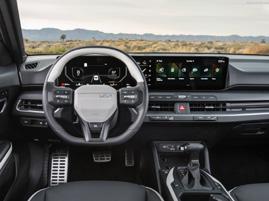
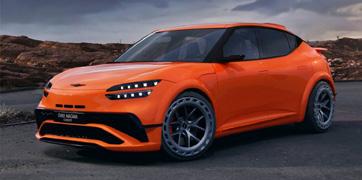
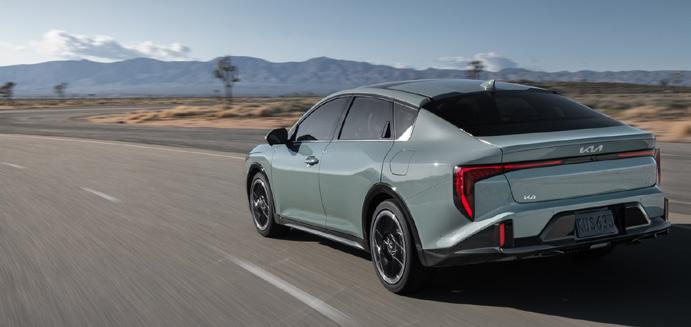

perforated pattern, and there’s a pop-up type roof rack.
A radiant heating system is efficient throughout the vehicle with heating films applied to the dashboard, door trims, floor, seatbacks and console sides.
The swivelling function of the front-row seats maximises space and practicality. The large adjustable display screen and flexible display that unfolds from the rear-seat headliner offer a sensory-stimulating experience.
The GV60 Magma, meanwhile, marks Genesis’ expansion into high performance. It ultimately aims to develop a Magma variant for each production model in its line-up.
This concept elevates the design and performance of the existing GV60, the brand’s first dedicated EV, with improved battery and motor technology.
To enhance stability during sporty driving, the car has been widened and lowered, giving it a more dynamic stance and lower centre of gravity.
At the front, a wider and lower main air intake in the bumper cools the batteries, motor and brakes, while air curtains enhance aerodynamic efficiency. Three holes above the main air intake provide extra cooling, while added canards assist in generating downforce on the front axle.
The enlarged fenders and integrated wheelhouse outlets help reduce kinetic energy and improve brake cooling. The titaniumcoloured 21-inch wheels feature integrated aero discs, which also help cool the brakes.
Fins have been placed on the roof to control the aerodynamic flow and channel it to the rear
wing, generating rear downforce and ensuring aerodynamic fluidity.
The GV60 Magma Concept’s distinctive exterior design extends into the sporty interior.
FLAGSHIP COUPE
Karma Automotive has revealed plans to release three EVs headlined by a “super coupe” capable of completing the 0-100kph dash in less than three seconds.
The Kaveya, its new flagship, will have a top speed of 290kph thanks to 880kW of power and 1,722Nm of
torque from its 120kWh battery.
The range-topper will be AWD. It will cover more than 400km on a single charge and will fast charge from 10-80 per cent in 45 minutes. Order books are expected to open towards the end of 2026.
For those unable to wait that long, the entry-level variant will arrive next year with key differences being RWD and output of around 400kW.
The Kaveya will be joined by two other models, the Revero and Gyesera, some time in the future.
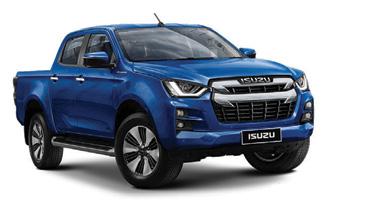



www.autofile.co.nz 27
Contact: Paul Curin pcurin@milesgroup.co.nz Hilux, Isuzu, GWM & Ranger 4x4 utes LATE MODEL, LOW KM t new cars
LOOKING TO BUY
The Genesis Neolun
The Kia K4
Genesis’ GV60 Magma
The Karma Kaveya
Sport farewells ardent supporter
Awho’s who from motor racing in New Zealand has paid tribute to Sir Colin Giltrap.
Scott Dixon dedicated his first IndyCar Series win of 2024 to Giltrap, who died on April 17, while dozens of drivers have carried memorial messages to him.
All Kiwis racing at Taupo last month, when the town hosted the ITM Super400, dedicated their races to Giltrap while his grandson Marco carried a touching message on his Porsche.
Over the past few decades, Giltrap has assisted almost every New Zealand racer of note. His influence on the sport has been enormous and the country is unlikely to see the likes of him again.
Before he built the automotive empire that bears his name – and before he began supporting and guiding rising Kiwis through the ranks – he himself was a driver.
He raced a Volvo with Jimmy Palmer in the 1963 Wills Six-Hour endurance race at Pukekohe, south of Auckland, and ran the same vehicle in the Sandown 500 with Ivan Segedin, winning their class and beating Palmer and Sir Jackie Stewart.
Giltrap was a keen family man and businessman with an allconsuming passion for cars and racing that never waned through all his life.
It was about a decade ago that he said motor racing here was going through a golden period.
“I can’t remember in my lifetime so many young New Zealanders competing in Europe,” enthused Giltrap of that era. “Most of them have either driven the A1GP car or in the Toyota [Racing Series].
“I would have to give Toyota full marks for getting that going. It brought a new era of single-seater racing to New Zealand, allowing these young guys to experience a taste of European-style singleseaters.”
Giltrap was the driving force behind the A1GP series in this
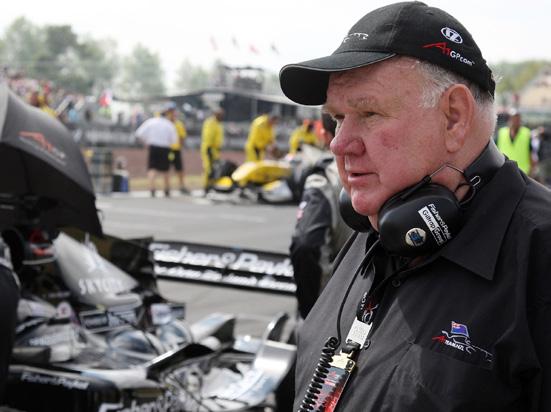

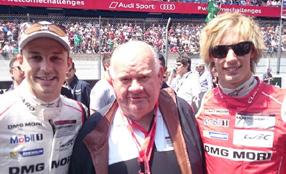
country and its round hosted on our shores.
A1GP was a “single make” open-wheel series, which ran from 2005-09 and had sprung up as an alternative to Formula 1. It featured cars with similar power and speed, using Zytec V8 race engines and then Ferrari road-derived powertrains.
Competitors solely represented their nation. As such, it was often promoted as the “world cup of motorsport”.
From the start, Giltrap was an ardent supporter of the series and the force behind A1 Team New Zealand, which ran Kiwis Earl Bamber, Chris van der Drift, Matt Halliday and Jonny Reid.
They twice came close to a championship win when Halliday and Reid brought Black Beauty home in second.
“I think Jonny Reid was an outstanding driver,” Giltrap later said. “He should have won the A1 series for us, but unfortunately it didn’t happen.
“He could have gone further, like a lot of the Kiwi drivers. However, the cards didn’t fall the
onto what was then the fledgling Formula E where he now competes with the Jaguar team.
And as for Scott Dixon, Giltrap told Autofile in 2016: “I’m so pleased to see him still winning. He’s absolutely fantastic.
“I remember Roger Penske told me a few years ago that he would love to get Scott in his team, he’s that good. I even helped him out with a car once.”
More recently, the new wave of stars to have received support from Giltrap have included his grandson, Liam Lawson, Callum Hedge and Hunter McElrea.
DRIVERS PAY TRIBUTE
right way and it’s hard to find the right sponsor.”
Giltrap described the A1 concept as “incredibly exciting”.
He initially dealt with Martin Birrane, who owned Lola and produced the cars, and the Irishman introduced him to Sheikh Maktoum which was when they “got some big names involved”.
“Emerson Fittipaldi bought the franchise in Brazil and Alan Jones in Australia. Support was strong, everybody loved it. A1 cost a lot of money, but it was wonderful, a true test of driving skill.”
Other leading drivers who have been supported by Giltrap down the years have included Brendon Hartley, Shane van Gisbergen, Mitch Evans and Hayden Paddon. Evans burst onto the New Zealand scene in 2010, winning the Toyota Racing Series aged just 16 before graduating onto the GP3GP2 career ladder in Europe.
After winning GP3, Evans faced a $3 million bill to move up into GP2, a step below F1. Backing from Giltrap helped make that happen.
Evans went on to finish second in the GP2 Series before moving
Giltrap was honoured at last month’s ITM Taupo Super400. Current Supercars drivers Matt Payne, Andre Heimgartner and Ryan Wood compete under the banner of Giltrap Motorsport and boast the company’s branding on their helmets.
Both Penrite Racing Fords carried tribute stickers at Taupo, with Payne and Richie Stanaway two of five Kiwis on the grid.
Supercars legend Greg Murphy said Giltrap’s passing was a “huge talking point in the paddock” at Taupo.
“Motorsport in this country wouldn’t be what it is without him, He loved being a part of it and had a great eye for talent. Those drivers who he has backed wear the Giltrap Group logo proudly.”
Kiwi Supercars driver Fabian Coulthard said Giltrap’s passing was a huge loss with him having done “so much for motorsport not only in New Zealand but globally too”.
KartSport NZ, the organisation where many young drivers who Giltrap supported would have started their careers, said: “Sir Colin has been at the forefront of not just the motor industry, but also one of the most influential and important supporters of all manner of sports and Kiwi athletes.
“The nation will forever be indebted to his quiet but substantial encouragement and assistance.”
28 www.autofile.co.nz motorsport
Sir Colin Giltrap on the grid at an A1GP race
A tribute to Giltrap on Richie Stanaway’s car at last month’s Taupo Super400
Giltrap with Earl Bamber, left, and Brendon Hartley at Le Mans in 2015
Next generation dominates rally
It was Jack Hawkeswood’s first national rally win and could signal a changing of the guard in the sport.
He and Robbie Stokes took out the top-two podium steps at this year’s Otago Rally.
Both come from families with pedigree in the sport. Their fathers, Andrew Hawkeswood and Brian Stokes, are former national rally championship winners.
Even better, Hawkeswood junior ticked off an event win that his dad never did in his long driving career.
“What a rally to win,” says the 23-year-old. “It was awesome all weekend and I really enjoyed it.”
Hawkeswood and navigator Jason Farmer also clinched top place in the Asia-Pacific and New Zealand Rally Championship fields in what was the former’s best performance in his young career.
The fight was fast over the weekend of April 13-14 in Otago

with little more than 20 seconds separating the top two on any occasion.
Hawkeswood took the win in his AP4-specified Toyota GR Yaris after he and second-placed Stokes battled to the final stages.
“I was packing myself all day that I was going to balls it up,” says Hawkeswood. “It was a little bit easier going but firm enough all day.”
For Stokes, second place is his best result at the event in seven
Kiwi victory at Taupo
The first race at the sold-out Taupo round of the V8 Supercars Championship delivered an historic career-first win for Andre Heimgartner in the series.
Competing in heavy rain, the Kiwi took victory on April 20 ahead of Shell V-Power Racing’s team-mates Will Davison and Anton de Pasquale.
Rising star Ryan Wood, 20, came home fourth, pressuring De Pasquale for the final podium
spot until the chequered flag.
Wood’s Walkinshaw Andretti
United team-mate Chaz Mostert had presented the biggest challenge to Heimgartner through the early stages, but he lost a right rear wheel after his second pit stop.
Richie Stanaway was the biggest mover in the field, climbing from 23rd to finish sixth.
There wasn’t much luck for home talent the next day. Red Bull Ampol Racing ran a dominant

outings, and it hands a great start to he and co-driver Sarah Brennan in their quest for the national championship.
Ben Hunt, of Auckland, was seeded first but struggled to hit top pace on the Saturday in his Skoda Fabia R2.
“We were trying and couldn’t keep up with them,” comments Hunt. “We had a bit of a crack and set a good time on the last stage, but probably a bit too late.”
Opotiki’s Mike Young had an impressive first showing in his Yaris AP4 to finish fourth, while Todd Bawden, of Hamilton, rounded out the top five in his Ford Fiesta R5.
Dunedin’s Emma Gilmour hit a hole and damaged the steering of her Citroen C3, which dropped her outside the top 30.
Then, over the course of the next 14 stages, she managed to charge back into sixth place by the end of the notoriously tricky final outing at Kuri Bush on the Sunday.
Current Rally America champion and professional freeride mountain biker, Brandon Semenuk, rolled. The Canadian says: “The infamous Kuri Bush got me. It was just a slow corner and I touched a bank. It kind of just grabbed the car and we had a really slow roll.
“It was a bummer way to go out of all the crazy stages we saw, but we whipped it back over and got through. It was nice to get to the end here.”

one-two final race of the ITM Taupo Super400 with Will Brown leading home Broc Feeney for a commanding one-two.
www.autofile.co.nz 29
09 966 1779 www.jevic.com S P E C I A L I S T S I N PRE‑SHIPMENT INSPECTIONS MPI biosecurity inspections Biosecurity decontamination Heat treatment Odometer verifications Pre-export appraisals NZTA border inspections ? Lost documentation reports
motorsport
De Pasquale finished third for the second consecutive race to win the coveted Jason Richards Memorial Trophy.
Andre Heimgartner celebrates his race victory at the Taupo Super400
Photo: Supercars
Jack Hawkeswood took a hard-fought win at Rally Otago.
Photo: Ross Hyde
Buyer fails to provide proof of problems after trader repairs vehicle’s other faults
Background
Marcial Villanueva purchased a 2013 Subaru XV with an odometer reading of 118,091km from Kiwi Cheap Cars for $25,000 on October 15, 2023.
Days later, he rejected it because he claimed the trader hadn’t fixed various faults. The dealer said it had remedied the issues and the buyer hadn’t collected the car.
The case
The first day Villanueva drove the vehicle, it made a loud noise so he returned it to the trader, which fixed it. He collected it on October 20.
The next day, the Subaru stalled at traffic lights. The buyer noticed the air conditioning wasn’t working and was making a loud noise.
When Villanueva bought the car, he said he was told it recently had a full service. But it needed coolant, the oil filter hadn’t been replaced, the oil wasn’t topped up, there wasn’t a service sticker and the handbrake was faulty.
He rejected the vehicle and took it back to Kiwi Cheap Cars on October 22 where it remained in storage.
After the application was filed, Villanueva said he turned up unannounced at the dealer’s premises in December and met general manager Rafay Ahmad.
He wanted his money back, but Ahmad said he couldn’t get a refund because the registration had been paid.
Soon after, Villanueva received an email saying his Subaru had been repaired and he could uplift it. But he didn’t collect the vehicle because he had rejected it.
The trader denied it told the buyer that the Subaru would be fully serviced prior to purchase.
Ahmad said the car had been remedied by its mechanic Kelston Tyres and Car Repairs. A wheel bearing and all four tyres were replaced.
It was again repaired when the purchaser took it back near the end of October complaining it had a broken air-conditioning unit and had stalled.
The trader said other faults, including the handbrake and lack of a service, weren’t mentioned by the buyer.
Ahmad said Villanueva turned up at the premises unannounced in early November and wanted to reject the vehicle. Ahmad told him Kiwi Cheap Cars was entitled to repair it.
He added that within two weeks of Villanueva bringing the Subaru in that it had been repaired and he was emailed on November 8 to collect it.
The trader was asked to provide the invoice relating to the second lot of repairs, but failed to do so.
On November 20, the dealer emailed the tribunal advising the Subaru had been repaired but Villanueva refused to uplift it.
The trader was happy to offer him the option of another vehicle in good faith.
The adjudicator noted Villanueva had to prove it was more probable than not that the facts he alleged took place.
Corroborating documents, such as invoices, videos, photos and reports, are often useful evidence to assist the tribunal in determining what the relevant facts are, what the necessary diagnosis may be, whether repairs have been undertaken and what took place.
The finding
The faulty wheel bearing, problematic and noisy airconditioning unit, and the issue that caused the Subaru to stall were present in the car at or closely to the time of sale.

A reasonable consumer of a second-hand vehicle would have realistic expectations about its condition and need for ongoing maintenance and repairs, but in this case the faults occurred too soon after purchase.
The Subaru wasn’t as free from minor defects or as durable as would be expected by a reasonable consumer of a car of this age, price and mileage, so the tribunal found the faults amounted to a failure of the CGA’s guarantee of acceptable quality.
But the fact it hadn’t been serviced prior to purchase didn’t amount to a failure of the guarantee and it isn’t uncommon for vehicles to be sold without a service.
Villanueva claimed he was told his Subaru would be supplied
The case: The buyer rejected his Subaru XV soon after it was supplied because it had a number of faults the trader hadn’t fixed. However, the dealer said it had repaired the problems and the purchaser had failed to collect his vehicle so it was placed in storage.
The decision: The tribunal said the trader had repaired the faults soon after purchase, so the buyer wasn’t entitled to reject the car under the Consumer Guarantees Act (CGA)
At: The Motor Vehicle Disputes Tribunal, Auckland.
case, failure to do so could have amounted to a breach of section nine of the Fair Trading Act.
However, the obligation was on the buyer to prove he was told the vehicle would come with a service.
The trader denied it promised to service the car and Villanueva had no corroborating evidence of that allegation other than his own oral evidence.
Also, he provided no evidence regarding issues with the handbrake, that it had no coolant, the oil filter needed replacing and the oil wasn’t topped up.
The trader was asked to fix the wheel-bearing fault, the air conditioning and the issue that caused the car to stall. It did so in a reasonable time.
Villanueva failed to provide evidence the Subaru’s faults hadn’t been repaired, so the tribunal found the buyer wasn’t entitled to any remedies under the CGA.

Also, for completion, the adjudicator mentioned that should Villanueva discover repairs hadn’t been completed, he was protected by the guarantee in section 28 of the CGA, which states that further services, if needed, are to be carried out with reasonable care and skill.
Any extra issues with the Subaru could be subject of another tribunal application. Order
The application was dismissed.
disputes
30 www.autofile.co.nz A 2013 Subaru XV
Tribunal says driver was fortunate car’s
failure didn’t take
Background
David Casanas purchased a 2010 BMW 535 GT from Motor Nation Group for $13,450 in February last year. Five months later, it suffered catastrophic engine failure with repairs estimated at $9,200.
He applied to reject the car. He also wanted to obtain a refund of the purchase price and other losses incurred as a result of the failure. The trader’s director, Qi Meng, resisted the buyer’s application to reject the car.

Although Motor Nation wasn’t formally incorporated at the time of this sale – that was done in April 2023 – Meng accepted it was a motor-vehicle trader and sold the BMW.
He told the tribunal Motor Nation ratified what was otherwise a pre-incorporation contract entered into by him. The consequence of that was the contract was valid and enforceable as if the company had been a party to the contract when it was made.
Meng said Motor Nation could repair the BMW for considerably less than Casanas’ estimated cost.
The case
Casanas said the BMW drove well for a couple of months until it began to make a clanking noise from its front. He notified Motor Nation Group about this but didn’t get a reply.
He thought the noise might be caused by a bearing or due to an issue with the suspension and asked a friend to inspect the vehicle. The friend couldn’t find anything wrong, so Casanas continued to drive it.
In July last year, the BMW broke down and the steering wheel locked causing Casanas to veer towards a pavement. He inched the car off the road and called for assistance.
place at high speed disputes
The case: The buyer wanted to reject his vehicle after it broke down about five months after purchase. He discovered the steering column had been modified and was unsafe. The trader denied any knowledge of the modification prior to purchase and said it would repair the car.
The decision: The tribunal agreed that the car’s fault was present prior to purchase and the issue was of a substantial character, so it upheld the consumer’s right to reject the vehicle.
At: The Motor Vehicle Disputes Tribunal, Christchurch.
A new battery failed to revive the vehicle and it was towed to a specialist workshop where a repairer identified multiple illegal and non-compliant repairs to the steering column.
The repairer noted shortcuts had been taken with repairs and various aspects were dangerously modified. Casanas was advised the fix would be expensive and require genuine replacement parts.
He discussed a repair with Motor Nation, which at first denied liability because Casanas had owned the BMW for three months, but then proposed it would carry out the repairs itself.
At the time of the hearing, the car was with the specialist repairer, which had dismantled the steering column and was awaiting further instructions.
Motor Nation denied liability for the faulty column. Meng produced various documents regarding the steering lock, which supported his submission he was unaware of any issues with the vehicle when he sold it.
Meng described the repairs as fairly straightforward, but noted Casanas had travelled 11,000km in the car over three months.
He accused Casanas of damaging the vehicle. The latter denied that and produced photographs which depicted, to the tribunal, a tidy looking car.
Meng complained the repair costs estimated to Casanas were grossly exaggerated and he could get the work done cheaper.

The tribunal’s assessor reviewed both parties’ evidence, and considered the specialist repairer’s diagnosis was correct and repairs would be expensive.
The assessor said there was no doubt that work or modifications carried out on the steering column before Casanas bought the BMW were poor and dangerous, and it was unroadworthy as a result.
It appeared the CAS units, which connected to the steering column, were modified in order to fit an after-market door key. The result was the vehicle was made unsafe, and the steering was compromised and illegal.
The finding
The tribunal found modifications to the car, which occurred prior to purchase, caused it to break down in breach of the guarantee of acceptable quality under section six of the Consumer Guarantees Act (CGA).
Casanas paid $13,450 for a 12-year-old European vehicle with more than 159,000km on the odometer when it was supplied.
A reasonable buyer of a vehicle of this price, age and mileage should have realistic expectations as to its quality and durability, understand it may have pre-existing wear and tear and defects, which might be expensive to repair and could arise as it was used.
But the BMW’s faults were more than minor and the
tribunal was satisfied Casanas had provided evidence that it wasn’t of acceptable quality. No reasonable consumer knowing of these repairs or modifications would have purchased it.
In addition, the steeringcolumn defect caused the vehicle to veer onto the pavement while it was being driven.
Casanas was fortunate that the car’s breakdown didn’t occur while he was travelling at high speed on the open road.
The BMW couldn’t be driven until it was repaired. It wasn’t safe or roadworthy and would fail a warrant of fitness.
Section 21 of the CGA applied in the case. The tribunal found the failure of the steering column was substantial because remedial work or modifications were unsafe.
The faults were there at the time of purchase. The adjudicator ruled Casanas was entitled to reject the BMW and was entitled to a refund of costs incurred by him arising from its failure.
The buyer produced an invoice for $956.70 covering the cost of the towing of the BMW and various diagnostic analyses.
Orders
The application to reject the vehicle was upheld. The trader had to pay the Casanas $13,450, collect the car and pay him $956.70 in compensation for consequential losses.
www.autofile.co.nz 31
A 2010 BMW 535 GT



For our latest schedule: armacup.co.nz/ schedules/asia-tooceania Armacup doing our bit for DRIVING THE PACIFIC 0800 ARMACUP (0800 276 2287) enquiries.NZ@armacup.com www.armacup.com

8,731
NORTHLAND NEW: 2023: USED: 2023: BAY OF PLENTY NEW: 2023: USED: 2023: AUCKLAND NEW: 2023: USED: 2023:
2023:
2023:
HAWKE ’S BAY
2023:
2023:
MANAWATU –WHANGANUI
2023: USED: 2023: WELLINGTON
2023: USED: 2023:
NEW: 2023: USED: 2023:


OTHERS
Islands, overseas, unknown)
(Chatham
GISBORNE NEW:
USED:
NEW:
USED:
NEW:
USED:
OTAGO NEW: 2023: USED: 2023: SOUTHLAND WAIKATO NEW: 2023: USED: 2023: TARANAKI NEW: 2023: USED: 2023: NELSON NEW: 2023: USED: 2023: TASMAN NEW: 2023: USED: 2023: WEST COAST NEW: 2023: USED: 2023: 248 323 265 302 6.4% 7.0% 651 1,288 721 1,151 9.7% 11.9% 28 40 32 30 12.5% 33.3% 46 42 63 25 27.0% 68.0% 36 67 30 42 20.0% 59.5% 45 74 45 55 0.0% 34.5% 721 620 727 582 0.8% 6.5% 288 259 278 167 3.6% 55.1% 123 127 129 116 4.7% 9.5% 199 193 173 177 15.0% 9.0% 29 68 25 46 16.0% 47.8% 348 387 425 351 18.1% 10.3% 591 718 599 625 1.3% 14.9% 2,531 4,237 3,272 4,015 22.6% 5.5% 143 146 138 132 3.6% 10.6% Whangarei Auckland Hamilton Thames Tauranga Rotorua Gisborne Napier New Plymouth Wanganui Palmerston North Masterton Wellington Nelson Blenheim Greymouth Whangarei Auckland Hamilton Thames Tauranga Rotorua Gisborne Napier New Plymouth Wanganui Palmerston North Masterton Wellington Nelson Blenheim Greymouth Westport Christchurch Timaru Oamaru Dunedin Invercargill Whangarei Auckland Hamilton Thames Tauranga Rotorua Gisborne Napier New Plymouth Wanganui Palmerston North Masterton Wellington Nelson Blenheim Greymouth Whangarei Auckland Hamilton Thames A R OUND T H E COUNT R Y
NEW:
NEW:
MARLBOROUGH
CANTERBURY
2023:
2023:
2023: 7,927 10.1 %
2023: 7,029 12.9 %
FINANCE TO SHIFT Y OUR BUSINESS I N TO TOP GEAR Your Vehicle Import Finance Specialist To find out more visit us at www.blackbirdf і nance.co.nz or call us on 0800 000 999
Total imported used cars 6,119
Total new cars April 2024
Imported Passenger Vehicle Sales by Make - April 2024
Imported Passenger Vehicle Sales by Model - April 2024
34 www.autofile.co.nz
MAKE MODEL APR '24 APR '23 +/- % APR 24 MKT SHARE 2024 YEAR TO DATE 2024 MKT SHARE Toyota Aqua 847 1,199 -29.4 9.7% 3,684 10.4% Toyota Prius 774 833 -7.1 8.9% 2,975 8.4% Mazda Axela 374 408 -8.3 4.3% 1,573 4.4% Toyota Corolla 366 307 19.2 4.2% 1,354 3.8% Nissan Note 355 300 18.3 4.1% 1,440 4.1% Honda Fit 284 276 2.9 3.3% 1,175 3.3% Toyota C-HR 283 160 76.9 3.2% 1,008 2.8% Subaru Impreza 262 199 31.7 3.0% 1,087 3.1% Mazda Demio 256 239 7.1 2.9% 1,145 3.2% Nissan X-Trail 253 173 46.2 2.9% 1,066 3.0% Mazda CX-5 219 157 39.5 2.5% 853 2.4% Nissan Serena 207 183 13.1 2.4% 985 2.8% Subaru XV 190 111 71.2 2.2% 743 2.1% Suzuki Swift 147 161 -8.7 1.7% 675 1.9% Honda Vezel 142 69 105.8 1.6% 562 1.6% Mitsubishi Outlander 131 174 -24.7 1.5% 579 1.6% Toyota Camry 127 76 67.1 1.5% 435 1.2% Volkswagen Golf 126 183 -31.1 1.4% 479 1.4% Mazda Atenza 122 85 43.5 1.4% 418 1.2% Toyota Vitz 113 124 -8.9 1.3% 592 1.7% Mazda Premacy 96 71 35.2 1.1% 403 1.1% Toyota Vellfire 92 24 283.3 1.1% 325 0.9% Nissan Leaf 80 201 -60.2 0.9% 264 0.7% Toyota Sai 80 102 -21.6 0.9% 309 0.9% Subaru Legacy 76 45 68.9 0.9% 222 0.6% Toyota Spade 72 31 132.3 0.8% 346 1.0% Subaru Forester 61 26 134.6 0.7% 227 0.6% Toyota Alphard 57 37 54.1 0.7% 210 0.6% Lexus CT 200h 51 22 131.8 0.6% 226 0.6% Toyota Auris 49 31 58.1 0.6% 240 0.7% Nissan Juke 47 44 6.8 0.5% 198 0.6% BMW 320i 45 38 18.4 0.5% 166 0.5% Honda Shuttle 44 24 83.3 0.5% 126 0.4% Toyota Wish 44 76 -42.1 0.5% 224 0.6% Volkswagen Polo 44 51 -13.7 0.5% 145 0.4% Others 2,215 1,687 31.3 25.4% 8,940 25.3% Total 8,731 7,927 10.1 100.0% 35,399 100.0%
MAKE APR '24 APR '23 +/- % APR '24 MKT SHARE 2024 YEAR TO DATE 2024 MKT SHARE Toyota 3,392 3,315 2.3 38.9% 13,641 38.5% Mazda 1,203 1,040 15.7 13.8% 4,973 14.0% Nissan 1,141 1,066 7.0 13.1% 4,819 13.6% Honda 738 584 26.4 8.5% 2,856 8.1% Subaru 688 443 55.3 7.9% 2,647 7.5% BMW 248 214 15.9 2.8% 931 2.6% Suzuki 216 215 0.5 2.5% 984 2.8% Mitsubishi 208 244 -14.8 2.4% 924 2.6% Volkswagen 198 274 -27.7 2.3% 738 2.1% Lexus 173 82 111.0 2.0% 707 2.0% Audi 156 136 14.7 1.8% 640 1.8% Mercedes-Benz 147 122 20.5 1.7% 589 1.7% Land Rover 37 17 117.6 0.4% 137 0.4% Ford 31 42 -26.2 0.4% 127 0.4% Jeep 18 4 350.0 0.2% 77 0.2% Jaguar 17 9 88.9 0.2% 66 0.2% Porsche 15 6 150.0 0.2% 60 0.2% Chevrolet 12 7 71.4 0.1% 52 0.1% Volvo 12 19 -36.8 0.1% 59 0.2% Mini 10 11 -9.1 0.1% 37 0.1% Tesla 10 2 400.0 0.1% 31 0.1% Dodge 9 6 50.0 0.1% 42 0.1% Holden 5 7 -28.6 0.1% 20 0.1% Peugeot 5 5 0.0 0.1% 22 0.1% Bentley 4 1 300.0 0.0% 13 0.0% Chrysler 4 4 0.0 0.0% 27 0.1% Buick 3 0 300.0 0.0% 5 0.0% Cadillac 3 2 50.0 0.0% 6 0.0% Daihatsu 3 6 -50.0 0.0% 13 0.0% MG 3 1 200.0 0.0% 6 0.0% Renault 3 1 200.0 0.0% 6 0.0% Smart 3 3 0.0 0.0% 7 0.0% Can-Am 2 0 200.0 0.0% 2 0.0% Hyundai 2 8 -75.0 0.0% 21 0.1% Plymouth 2 1 100.0 0.0% 8 0.0% Others 10 30 -66.7 0.1% 106 0.3% Total 8,731 7,927 10.1 100.0% 35,399 100.0% WHAT DO YOU WANT FROM YOUR VEHICLE SUPPLIER?
Warning issued over electric fees
The NZTA has issued a reminder to owners of battery electric vehicles (BEVs) and plug-in hybrids (PHEVs) that they became liable for roaduser charges from April 1.
Tara Macmillan, head of strategic regulatory programmes, says the quickest and easiest way to pay is online.
“Just go to the NZTA website, click on ‘online services’ then ‘buy a road user charges (RUC) licence’. You need to give your odometer reading when you buy your first licence and keep up to date going forward.”
BEV and PHEV owners have until May 31 to purchase RUC at $76/1,000km and $38/1,000km respectively, with administration charges on top.
“While we encourage people to buy their first licence as soon as possible, there’s a two-month transition to allow time for people to make the change,” adds Macmillan.
Anyone who hasn’t bought their first licence by May 31 risks being penalised and receiving an infringement notice.
“It’s an offence for a RUC vehicle to not have a current and valid RUC licence.
“We hold details of all EVs in our system, so we’ll know who hasn’t bought their first licence and will be following up directly.
Sales spike
Used-imported car registrations climbed by 10.1 per cent in April –8,731 versus 7,927 during the same month of last year.
increased by three per cent over the same timescale and the only other category in decline over that period was mortgages with a fall of 6.2 per cent.
The models’ ladder was topped by the Toyota Aqua on 847 units. Next up were the Prius on 774 and Mazda’s Axela with 374. Last month’s top three marques were Toyota with 3,392 units, up by 2.3 per cent on April 2023. Next up were Mazda with 1,203 and Nissan on 1,141.
“Every time a vehicle goes for a warrant of fitness, we also get the odometer reading, which means we can match that to any unpaid RUC.”
BEVs and PHEVs had been exempt from road-user charges since 2009. But with around 100,000 now on our roads, the government opted to let the exemption end.
This means owners of such vehicles now contribute to the costs of the transport system in the same way as others.
Used Imported Passenger Registrations - 2020 – 2024
CAR LENDING DOWN
Demand for motor-vehicle loans continues to slide with the number of applications dropping by 16 per cent in March when compared to the same month in 2023. Centrix says the figure is indicative of declining newcar sales across the board and follows a 12 per cent year-on-year decrease in February.
The credit bureau notes overall consumer credit demand
As for the proportion of vehicle loans in arrears, that dropped from six per cent in January to 5.7 per cent in February. However, the latest figure was up from 5.4 per cent in February last year.
Centrix adds the overall number of Kiwis in arrears fell back as expected in February to 12.5 per cent of the credit active population or 457,000 people. In January, the numbers stood at 13.1 per cent and 480,000 consumers.
Meanwhile, Tower Ltd now expects underlying net profit after tax to “be at the upper end of or exceed” the previously anticipated range of between $22 million and $27m for 2023/24. The guidance follows “strong trading results” during the first four months of the financial year.


www.autofile.co.nz 35 contact: Koh Nagata email: nagata@heiwa-auto.co.jp www.heiwa-auctions.com SOLID COMPANY QUALITY VEHICLES CHOICE & VARIETY OF STOCK EXPERIENCED AGENTS DEALER ONLY SUPPLIER GREAT VALUE FOR MONEY 0 5,000 10,000 15,000 20,000 25,000 1 2 3 4 5 6 7 8 9 10 11 12 2020 2021 2022 2023 2024
Used Imported Passenger Vehicle Sales by Motive Power - April 2024 MAKE APR '24 APR '23 +/- % APR '24 MKT SHARE 2024 YEAR TO DATE 2024 MKT SHARE Full battery electric 100 216 -53.7% 1.1% 338 1.0% Plug-in hybrid electric 117 186 -37.1% 1.3% 451 1.3% Non plug-in petrol hybrid 4,070 3,878 5.0% 46.6% 16,380 46.3% Petrol 4,337 3,532 22.8% 49.7% 17,776 50.2% Diesel 107 115 -7.0% 1.2% 453 1.3% Others (includes non plug-in diesel hybrid, fuel cell) 0 0 0.0% 0.0% 1 0.0% Total 8,731 7,927 10.1% 35,399
Port set to hit profit target
Full-year net profit after tax (NPAT) of $52 million is set to be delivered by Port of Auckland Ltd (POAL).
Roger Gray, chief executive officer, says a dividend of at least $35m should go to Auckland Council, which owns the port, for the 2023/24 reporting period.
“We have made significant improvements across the business,” he adds. “We remain focused on safely lifting performance, delivering returns to the council, and improving how we support and engage with our customers and the people of Auckland.”
POAL has reported its NPAT
came in at $21.2m for the six months to the end of December, up by $400,000 from $20.8m on the previous corresponding period.
This was despite revenue from demurrage, or cargo holding, dropping by $15m over the same timescale as supply-chain congestion issues eased.
The company’s half-year results also show revenue increased from $159.5m to $162.5m and net debt levels fell by $9m to $397.6m.
The figures mean its first-half dividend to Auckland Council was $20m for an increase of 33 per cent from $15m in the same period a year ago.
Gray says: “Our first-half profit of $21.2m, considering we had a reduction in demurrage revenue of $15m, shows that the port’s turnaround strategy is working.”
POAL highlights total laden import and exports for the first half increased from 204,088 to 225,128 twenty-foot equivalent containers, which represented an eight per cent increase in its upper North Island market share.
It was also on track for a record cruise season and lost-time injuries reduced by 85 per cent in the half-year when compared with a year ago.
Jan Dawson, who chairs the
company, describes the results as pleasing given the challenging economic environment and supply-chain disruptions over the first half of 2023/24.
YEAR’S BIGGEST MONTH
There were 11,638 used passenger vehicles imported into New Zealand during April – the most for any month in 2024. The year-todate total is now 37,850.
Japan accounted for 98 per cent of the overall market with 11,411 units. In addition, 164 crossed the border from Australia, 20 from Singapore, 17 from the US and 14 came in from the UK.

36 www.autofile.co.nz WWW.DOLPHINSHIPPING.CO.NZ +64 9 303 0075 VEHICLE SHIPPING EXPERTS GET A QUOTE FROM OUR TEAM TODAY CUSTOMISED SOLUTIONS 30 YEARS EXPERIENCE MONTHLY SAILINGS
20,000 19,000 18,000 17,000 16,000 15,000 14,000 13,000 12,000 11,000 10,000 9,000 8,000 7,000 6,000 4,000 JAN FEB MAR APR MAY JUN JUL AUG SEPT OCT NOV DEC 2021 2020 2019 2022 2023 2024 USED IMPORTED PASSENGER VEHICLE ARRIVALS Used Imported Passenger Vehicles By Country Of Export COUNTRY OF EXPORT 2024 2023 2022 JAN ’24 FEB ’24 MAR ’24 APR ’24 APR MRKT SHARE % 2024 TOTAL Q1 Q2 Q3 Q4 2023 TOTAL MRKT SHARE 2022 TOTAL MRKT SHARE Australia 72 109 105 164 1.4% 450 338 306 267 352 1,263 1.1% 2,353 2.6% Great Britain 19 27 14 14 0.1% 74 75 60 58 79 272 0.2% 512 0.6% Japan 7,984 7,281 10,437 11,411 98.0% 37,113 23,317 32,064 32,800 25,281 113,462 98.0% 87,740 95.6% Singapore 18 43 28 20 0.2% 109 50 75 48 77 250 0.2% 423 0.5% USA 12 21 11 17 0.1% 61 68 56 83 58 265 0.2% 487 0.5% Other countries 12 10 9 12 0.1% 43 48 61 61 71 241 0.2% 250 0.3% Total 8,117 7,491 10,604 11,638 100.0% 37,850 23,896 32,622 33,317 25,918 115,753 100.0% 91,765 100.0%
Growth boosts business value
MTF Finance’s chief executive officer says the company’s increased value has come after a period of sustained growth.
“We are confident MTF is wellplaced to continue this growth in coming years,” adds Chris Lamers.
“Change often happens at a crossroads or confluence of events. I believe we are at one of those moments in time. This is why we’re evolving MTF and our network to meet the changing needs of customers.
“Particularly during a global cost-of-living crisis, putting customers at the forefront of
lending is crucial. Over the past 12 months, we have invested more in new locally owned and operated branches and additional staff in communities.”
Before the company’s recent annual general meeting, the board resolved to increase the current dividend reinvestment strike price for ordinary shares from $2.50 to $3.84.
The rise is being seen as a marker of the success it has been having, and a direct reflection of strong performance and the business’ increasing scale.
Chairman Mark Darrow notes 2023/24 returned a record result
SECONDHAND CAR SALES - April 2024
that has “proven the strategic path for the business has been successful”.
“Reaching $1 billion in lending assets is a landmark that provides important scale for MTF and puts us near the top of non-bank lenders in New Zealand,” he says.
Geneva Finance, meanwhile, has assessed the contributions of the group’s different business units and has decided to focus primarily on its two core operations – lending and insurance.
Consequently, the board has made the strategic decision to exit the invoice factoring and debt-litigation operations, which
requires a reassessment and writeoff of associated goodwill.
Despite these adjustments, anticipated year-end results remain closely aligned with what was announced for the half-year.
INCREASE IN TRADE
There were 14,327 second-hand cars sold by dealers to the public in April, which was an increase of 8.4 per cent from 13,214 during the same month in 2023.
There were also 12,801 publicto-trader deals last month, which was up by 12.3 per cent from 11,399 over the same timescale, and 39,525 private transactions.





www.autofile.co.nz 37 Visit autofile.co.nz/jobs to view the latest jobs in the automotive industry
DEALER TO PUBLIC PUBLIC TO PUBLIC PUBLIC TO DEALER REGION APR '24 APR 23 +/- % MARKET SHARE APR '24 APR '23 +/- % APR '24 APR '23 +/- % Northland 428 431 -0.7% 3.0% 1,725 1,749 -1.4% 182 168 8.3% Auckland 4,869 4,842 0.6% 34.0% 13,348 13,905 -4.0% 5,377 5,012 7.3% Waikato 1,486 1,322 12.4% 10.4% 3,836 3,785 1.3% 1,105 1,034 6.9% Bay of Plenty 905 792 14.3% 6.3% 2,791 2,834 -1.5% 611 557 9.7% Gisborne 130 120 8.3% 0.9% 403 365 10.4% 36 37 -2.7% Hawke’s Bay 543 554 -2.0% 3.8% 1,389 1,438 -3.4% 425 340 25.0% Taranaki 335 297 12.8% 2.3% 1,008 994 1.4% 176 182 -3.3% Manawatu-Whanganui 770 648 18.8% 5.4% 2,033 1,964 3.5% 690 672 2.7% Wellington 1,360 1,114 22.1% 9.5% 2,997 3,052 -1.8% 1,143 862 32.6% Tasman 110 109 0.9% 0.8% 443 424 4.5% 14 16 -12.5% Nelson 116 124 -6.5% 0.8% 365 359 1.7% 181 154 17.5% Marlborough 135 103 31.1% 0.9% 390 403 -3.2% 60 67 -10.4% West Coast 84 93 -9.7% 0.6% 296 288 2.8% 32 25 28.0% Canterbury 2,033 1,777 14.4% 14.2% 5,312 5,125 3.6% 2,146 1,787 20.1% Otago 705 550 28.2% 4.9% 2,074 1,967 5.4% 465 390 19.2% Southland 266 273 -2.6% 1.9% 972 873 11.3% 158 96 64.6% Other 52 65 -20.0% 0.4% 143 138 3.6% 0 0 0.0% NZ Total 14,327 13,214 8.4% 100.0% 39,525 39,663 -0.3% 12,801 11,399 12.3%
new cars
New Passenger Vehicle Sales by Make - April 2024
New Passenger Vehicle Sales by Model - April 2024
38 www.autofile.co.nz
MAKE MODEL APR '24 APR '23 +/- % APR '24 MKT SHARE 2024 YEAR TO DATE 2024 MKT SHARE Toyota RAV4 1,011 537 88.3 16.5% 2,883 10.4% Suzuki Swift 256 276 -7.2 4.2% 935 3.4% Mitsubishi Outlander 245 178 37.6 4.0% 1,208 4.4% Kia Seltos 207 152 36.2 3.4% 966 3.5% Ford Everest 182 102 78.4 3.0% 814 2.9% Mitsubishi ASX 180 31 480.6 2.9% 1,101 4.0% Toyota Yaris Cross 152 94 61.7 2.5% 475 1.7% Kia Stonic 132 92 43.5 2.2% 723 2.6% Kia Sportage 129 77 67.5 2.1% 558 2.0% Nissan X-Trail 128 85 50.6 2.1% 487 1.8% Toyota Corolla Cross 125 60 108.3 2.0% 677 2.4% Suzuki Jimny 119 84 41.7 1.9% 380 1.4% MG ZS 115 246 -53.3 1.9% 573 2.1% Toyota Yaris 108 90 20.0 1.8% 286 1.0% Toyota Corolla 105 148 -29.1 1.7% 435 1.6% Hyundai Kona 98 136 -27.9 1.6% 369 1.3% Mazda CX-5 98 96 2.1 1.6% 492 1.8% Mitsubishi Eclipse Cross 91 326 -72.1 1.5% 586 2.1% GWM Haval Jolion 90 0 9,000.0 1.5% 382 1.4% GWM Haval H6 81 0 8,100.0 1.3% 402 1.5% Ford Escape 73 61 19.7 1.2% 218 0.8% GWM Tank 72 0 7,200.0 1.2% 206 0.7% Hyundai Tucson 70 67 4.5 1.1% 301 1.1% Honda ZR-V 60 0 6,000.0 1.0% 419 1.5% Volkswagen Tiguan 60 76 -21.1 1.0% 267 1.0% Kia Niro 59 142 -58.5 1.0% 230 0.8% Honda Jazz 58 42 38.1 0.9% 294 1.1% Nissan Qashqai 53 41 29.3 0.9% 457 1.7% Omoda C5 49 0 4,900.0 0.8% 50 0.2% Tesla Model Y 48 127 -62.2 0.8% 292 1.1% Toyota C-HR 47 55 -14.5 0.8% 179 0.6% MG MG3 45 51 -11.8 0.7% 191 0.7% Subaru Outback 45 39 15.4 0.7% 191 0.7% Suzuki S-Cross 44 28 57.1 0.7% 186 0.7% Honda CR-V 43 35 22.9 0.7% 344 1.2% Suzuki Ignis 41 44 -6.8 0.7% 217 0.8% Skoda Kodiaq 39 23 69.6 0.6% 105 0.4% Subaru Crosstrek 39 0 3,900.0 0.6% 189 0.7% MG HS 37 35 5.7 0.6% 92 0.3% Hyundai Santa Fe 36 50 -28.0 0.6% 225 0.8% Kia Sorento 35 122 -71.3 0.6% 146 0.5% Subaru Forester 35 59 -40.7 0.6% 157 0.6% Lexus NX 33 32 3.1 0.5% 153 0.6% Ford Puma 30 69 -56.5 0.5% 202 0.7% Mini Countryman 30 36 -16.7 0.5% 114 0.4% Others 1,286 2,985 -56.9 21.0% 7,529 27.2% Total 6,119 7,029 -12.9 100.0% 27,686 100.0%
MAKE APR '24 APR 23 +/- % APR '24 MKT SHARE 2024 YEAR TO DATE 2024 MKT SHARE Toyota 1,663 1,357 22.5 27.2% 5,991 21.6% Kia 595 707 -15.8 9.7% 2,812 10.2% Mitsubishi 542 675 -19.7 8.9% 3,072 11.1% Suzuki 488 520 -6.2 8.0% 1,856 6.7% Ford 321 345 -7.0 5.2% 1,414 5.1% GWM 248 26 853.8 4.1% 1,025 3.7% Hyundai 219 395 -44.6 3.6% 1,037 3.7% Nissan 214 164 30.5 3.5% 1,068 3.9% MG 208 334 -37.7 3.4% 933 3.4% Mazda 182 226 -19.5 3.0% 1,059 3.8% Honda 172 90 91.1 2.8% 1,144 4.1% Volkswagen 155 225 -31.1 2.5% 688 2.5% Subaru 127 149 -14.8 2.1% 619 2.2% Lexus 104 126 -17.5 1.7% 463 1.7% Skoda 94 151 -37.7 1.5% 394 1.4% Mercedes-Benz 93 116 -19.8 1.5% 468 1.7% Land Rover 82 108 -24.1 1.3% 443 1.6% Audi 78 121 -35.5 1.3% 413 1.5% BMW 73 126 -42.1 1.2% 525 1.9% Tesla 67 197 -66.0 1.1% 445 1.6% Omoda 59 0 5,900.0 1.0% 62 0.2% Mini 55 51 7.8 0.9% 241 0.9% Volvo 41 50 -18.0 0.7% 135 0.5% BYD 28 181 -84.5 0.5% 153 0.6% Alfa Romeo 26 0 2,600.0 0.4% 37 0.1% Porsche 23 47 -51.1 0.4% 199 0.7% Peugeot 16 69 -76.8 0.3% 162 0.6% Mahindra 14 21 -33.3 0.2% 132 0.5% Cupra 12 18 -33.3 0.2% 106 0.4% Polestar 11 44 -75.0 0.2% 27 0.1% Jaguar 10 8 25.0 0.2% 73 0.3% Jeep 10 32 -68.8 0.2% 56 0.2% Isuzu 8 11 -27.3 0.1% 39 0.1% KGM 8 0 800.0 0.1% 29 0.1% Opel 8 28 -71.4 0.1% 19 0.1% Citroen 7 15 -53.3 0.1% 29 0.1% SsangYong 7 29 -75.9 0.1% 68 0.2% Bentley 5 5 0.0 0.1% 13 0.0% Fiat 5 10 -50.0 0.1% 15 0.1% Ineos 5 0 500.0 0.1% 28 0.1% Renault 5 13 -61.5 0.1% 19 0.1% Aston Martin 4 4 0.0 0.1% 18 0.1% Ferrari 4 5 -20.0 0.1% 14 0.1% Haval 4 199 -98.0 0.1% 38 0.1% Others 19 31 -38.7 0.3% 105 0.4% Total 6,119 7,029 -12.9 100.0% 27,686 100.0%
‘New chapter’ for dealership
Ingham Motor Group has expanded its network of North Island franchises after acquiring Windsor Nissan.
It has rebranded the business as Ingham Nissan Cambridge to increase the sites it operates to 21.
Ross Dodds remains as dealer principal and a number of other staff have also been retained by Ingham, which plans to extend the premises in the future.
“Becoming part of the Ingham family represents a new chapter for our team and community,” says Dodds.
“Our focus on providing a wide range of quality vehicles with exceptional service and aftersales support remains stronger than ever. We look forward to drawing on Ingham’s extensive resources, knowledge and expertise.”

Numbers down
Sales of new passenger vehicles fell by 12.9 per cent last month when compared to April 2023 – from 7,029 to 6,119.
The month’s top model was Toyota’s RAV4 with 1,011 units, which amounted to a jump of 88.3 per cent over the same timescale. Next were Suzuki’s Swift with 256 and Mitsubishi’s Outlander on 245.
Trent Ingham, group managing director, says the company has operated in the Waikato for more than four decades and is excited to add another Nissan dealership to its portfolio.
“Windsor Nissan has been a prominent player in the market since the early 1980s, so it was an ideal fit for us,” he adds.
“We feel Nissan’s range aligns incredibly well with the area’s needs and are thrilled to have the dealership on board.”
April’s most popular marques were Toyota with 1,663 registrations, Kia with 595 and Mitsubishi on 542.
CLEARING EV STOCK
Volkswagen NZ has cut its expectations for annual sales of electric vehicles (EVs) and is revising how many it imports following the demise of the clean car discount (CCD).
Chanelle McDonald, general manager for passenger vehicles, says the feebates scheme helped boost demand for zero-emitters.
However, registrations of such models have dropped since the CCD was axed at the end of 2023.
She adds the company had forecast 30 per cent of its sales would be EVs last year, but that target has been slashed to 10 per cent for 2024.
Volkswagen NZ launched the all-electric ID.4 and ID.5 only months before the coalition government announced its timeframe for ditching the CCD.
As a result, the marque offered discounts on some EVs to clear excess stock it had hoped would still be eligible for rebates this year.
McDonald explains New Zealand also stopped ordering new ID.4s and ID.5s when National won the election as the company prepared itself for the CCD’s demise.
“We had a clear mission to go hard with electrification here and it feels that has stalled a wee bit with
the decision to remove the rebate.” She predicts a more “normalised and stable market” will take shape from April.
Losses on EV sales are expected to be balanced by growth in registrations of models that attracted penalties under the CCD.
DEAL WITH CRUSADERS
Miles Kia in Christchurch has become the Crusaders’ official vehicle partner, supplying models including the Sorento, Sportage and Stonic.
“The support the Crusaders give to the community is amazing,” says Jodie Tait, general manager of Miles Kia. “We are pleased to be part of that and drive them on their journey.
“Our brand has always been innovative and continues to look at ways to excel. This commitment aligns with the Crusaders.”
Colin Mansbridge, the Crusaders’ chief executive officer, adds: “We’re excited to have Miles Kia on board. It has long played an important role in our community and we see so many similarities between our two organisations.”
The announcement follows the dealership’s brand change from Cockram Kia to Miles Kia.
While the business has always been owned by Bruce Miles, Tait says the name change better aligns Miles Kia to the Miles Group of brands.
www.autofile.co.nz 39 new cars
0 2,000 4,000 6,000 8,000 10,000 12,000 14,000 16,000 18,000 Jan Feb Mar Apr May Jun Jul Aug Sep Oct Nov Dec 2020 2021 2022 2023 2024
Passenger Registrations - 2020 – 2024
New
- April 2024 MAKE APR '24 APR 23 +/- % APR 24 MKT SHARE 2024 YEAR TO DATE 2024 MKT SHARE Full battery electric 262 1,052 -75.1% 4.3% 1,343 4.9% Plug-in hybrid electric 183 567 -67.7% 3.0% 773 2.8% Non plug-in petrol hybrid 2,435 1,795 35.7% 39.8% 9,365 33.8% Petrol 2,780 2,969 -6.4% 45.4% 13,658 49.3% Diesel 458 646 -29.1% 7.5% 2,546 9.2% Others (includes non plug-in diesel hybrid, fuel cell) 1 0 0.0% 0.0% 1 0.0% Total 6,119 7,029 -12.9% 27,686
New Passenger Vehicle Sales by Motive Power
The Crusaders’ Colin Mansbridge, left, with Jodie Tait, of Miles Kia
Market for utes hotting up
The all-new, fully electric
Isuzu D-Max could be bound for our shores sometime next year.
The manufacturer’s concept of its dual-cab model made its debut at Bangkok International Motor Show ahead of its production release in 2025.
It will initially be launched in select European markets, such as Norway, before going on sale in the UK, Thailand and Australia.
Although New Zealand has yet to be confirmed, the marque’s local arm says that we can expect to hear word of its availability “soon”.
The electric D-Max is expected to feature a 66.9kWh lithium-ion
battery, as well as two electric motors for 130kW of power and 325Nm of torque.
Its payload and towing capacity are said to be on a par with popular petrol and diesel-powered utes at
1,000kg and 3,500kg respectively.
The conventional D-Max notched up 1,038 registrations in New Zealand last year to claim a 2.7 per cent share of the new commercial market.
New Commercial Sales - 2020 – 2024
Meanwhile, BYD is looking to launch its first ute into global markets later this year.
It has yet to release information about the powertrain, performance or pricing, but says the mid to full-size vehicle will be its first “new energy” pick-up.
The marque has been pushing into markets, such as New Zealand, Australia, Asia and South America, where utilities are popular.
MILESTONE REACHED
The team at General Motors Speciality Vehicles (GMSV) has celebrated the 10,000th Silverado to come off its remanufacturing line.
The model-year 2024 Chevrolet Silverado 2500 HD was completed
New Commercial Sales by Model - April 2024




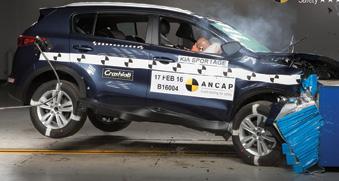
40 www.autofile.co.nz 0 2,000 4,000 6,000 8,000 10,000 Jan Feb Mar Apr May Jun Jul Aug Sep Oct Nov Dec 2020 2021 2022 2023 2024
new commercials
New Commercial Sales by Make - April 2024 MAKE APR '24 APR '23 +/- % APR '24 MKT SHARE 2024 YEAR TO DATE 2024 MKT SHARE Ford 944 971 -2.8 30.3% 4,771 31.0% Toyota 716 896 -20.1 23.0% 3,377 21.9% Mitsubishi 406 256 58.6 13.0% 1,850 12.0% Isuzu 190 174 9.2 6.1% 933 6.1% Nissan 174 104 67.3 5.6% 862 5.6% Fuso 76 107 -29.0 2.4% 352 2.3% Volkswagen 76 49 55.1 2.4% 464 3.0% Scania 53 35 51.4 1.7% 227 1.5% Mercedes-Benz 51 37 37.8 1.6% 275 1.8% Hino 46 48 -4.2 1.5% 177 1.2% LDV 45 89 -49.4 1.4% 202 1.3% Fiat 33 23 43.5 1.1% 232 1.5% Hyundai 33 87 -62.1 1.1% 214 1.4% Iveco 24 28 -14.3 0.8% 152 1.0% Volvo 23 11 109.1 0.7% 124 0.8% DAF 22 27 -18.5 0.7% 118 0.8% Ram 22 24 -8.3 0.7% 102 0.7% Kenworth 21 7 200.0 0.7% 105 0.7% GWM 20 0 2,000.0 0.6% 42 0.3% Mazda 20 29 -31.0 0.6% 85 0.6% Others 119 113 5.3 3.8% 724 4.7% Total 3,114 3,115 0.0 100.0% 15,388 100.0%
MAKE MODEL APR '24 APR '23 +/- % APR '24 MKT SHARE 2024 YEAR TO DATE 2024 MKT SHARE Ford Ranger 836 927 -9.8 26.8% 4,267 27.7% Toyota Hilux 512 651 -21.4 16.4% 2,472 16.1% Mitsubishi Triton 405 256 58.2 13.0% 1,849 12.0% Nissan Navara 174 104 67.3 5.6% 862 5.6% Toyota Hiace 162 186 -12.9 5.2% 684 4.4% Ford Transit 108 44 145.5 3.5% 504 3.3% Isuzu D-Max 73 83 -12.0 2.3% 505 3.3% Isuzu F Series 66 38 73.7 2.1% 191 1.2% Volkswagen Amarok 44 16 175.0 1.4% 330 2.1% Toyota Land Cruiser 42 55 -23.6 1.3% 213 1.4% Mercedes-Benz Sprinter 38 24 58.3 1.2% 194 1.3% Isuzu N Series 37 41 -9.8 1.2% 184 1.2% LDV Deliver 9 35 11 218.2 1.1% 102 0.7% Fiat Ducato 33 22 50.0 1.1% 232 1.5% Volkswagen Crafter 24 19 26.3 0.8% 73 0.5% Hino 300 23 12 91.7 0.7% 70 0.5% Hyundai Staria Load 22 78 -71.8 0.7% 185 1.2% DAF CF 21 25 -16.0 0.7% 110 0.7% GWM Cannon 20 0 2,000.0 0.6% 42 0.3% Mazda BT-50 20 29 -31.0 0.6% 85 0.6% Others 419 494 -15.2 13.5% 2,234 14.5% Total 3,114 3,115 0.0 100.0% 15,388 100.0% Know what’s going on in YOUR industry
at the GMSV facility in Victoria.
Jess Bala, managing director of GM Australia and New Zealand, says: “As we celebrate this milestone, I would like to thank our remanufacture partner Premoso, our dealer partners and customers for their support.”
GMSV has been remanufacturing the Silverado range for four years with Premoso. Twenty vehicles per day leave the facility.
It was in November 2020 that GMSV was launched, and sales of the Silverado 1500 range started New Zealand and Australia.
The next year saw the 2500 HD launched in both countries and the company’s facility near Melbourne opened in August 2022.
March 2023 was when sales of that model year’s Silverado 1500 got under way and its ZR2 sibling launched before the latest 2500
HD arrived across the Tasman late last year.
LET’S GO WARRIORS
GWM NZ has become the One New Zealand Warriors’ automotive partner in a multi-year deal.
In addition to providing a fleet of vehicles, the marque’s name appears on the sternum position
of jerseys for each of the club’s five teams this season. It also has naming rights to the match-day entertainment area at the northern end of Go Media Stadium.
Sean Tupp, GWM NZ’s national sales manager, says: “As we continue to grow the business, this exciting new partnership has come at just the right time.
“With our range of tough and highly capable utes and SUVs, there’s a real synergy between GWM and the Warriors.”
REGISTRATIONS STEADY
Sales of new commercials during April came in at 3,114 units, only one less than in the same month of last year.
The Ford Ranger was the bestselling model on 836, down by 9.8 per cent. Toyota’s Hilux came second with 512 and Mitsubishi’s Triton was third on 405.
Ford was April’s most popular marque with 944 units, down by 2.8 per cent from 971 during the same month of 2023.
The total for used-imported commercials was 483 for a yearon-year rise of 11.8 per cent from 432 with Toyota’s Hiace on 200 units – up by 34.2 per cent.
Used Commercial Sales by Model -


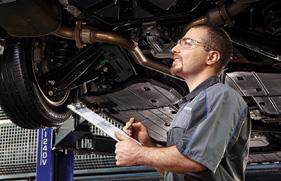

www.autofile.co.nz 41 Used
- April 2024 MAKE APR 24 APR 23 +/- % APR '24 MKT SHARE 2024 YEAR TO DATE 2024 MKT SHARE Toyota 263 199 32.2 54.5% 1,213 50.8% Nissan 97 86 12.8 20.1% 520 21.8% Isuzu 29 41 -29.3 6.0% 120 5.0% Hino 17 29 -41.4 3.5% 118 4.9% Ford 16 16 0.0 3.3% 114 4.8% Mitsubishi 16 23 -30.4 3.3% 92 3.9% Mazda 8 5 60.0 1.7% 35 1.5% Suzuki 6 4 50.0 1.2% 20 0.8% Daihatsu 5 10 -50.0 1.0% 19 0.8% Chevrolet 4 0 400.0 0.8% 16 0.7% UD Trucks 4 3 33.3 0.8% 9 0.4% Holden 3 1 200.0 0.6% 11 0.5% Mercedes-Benz 3 0 300.0 0.6% 7 0.3% AM General 2 0 200.0 0.4% 2 0.1% Volvo 2 0 200.0 0.4% 10 0.4% Dodge 1 2 -50.0 0.2% 11 0.5% Factory Built 1 0 100.0 0.2% 3 0.1% Freightliner 1 1 0.0 0.2% 3 0.1% Hyundai 1 0 100.0 0.2% 4 0.2% Iveco 1 1 0.0 0.2% 2 0.1% Others 3 11 -72.7 0.6% 59 2.5% Total 483 432 11.8 100.0% 2,388 100.0%
Commercial Sales by Make
April 2024 MAKE MODEL APR '24 APR '23 +/- % APR 24 MKT SHARE 2024 YEAR TO DATE 2024 MKT SHARE Toyota Hiace 200 149 34.2 41.4% 926 38.8% Nissan NV350 66 55 20.0 13.7% 334 14.0% Toyota Regius 30 19 57.9 6.2% 142 5.9% Isuzu Elf 21 30 -30.0 4.3% 85 3.6% Toyota Dyna 18 19 -5.3 3.7% 76 3.2% Hino Dutro 14 25 -44.0 2.9% 89 3.7% Nissan Caravan 14 13 7.7 2.9% 85 3.6% Fuso Canter 11 15 -26.7 2.3% 65 2.7% Nissan NV200 10 3 233.3 2.1% 48 2.0% Isuzu Forward 7 8 -12.5 1.4% 24 1.0% Suzuki Carry 6 4 50.0 1.2% 18 0.8% Toyota Toyoace 6 4 50.0 1.2% 31 1.3% Daihatsu Hijet 5 10 -50.0 1.0% 19 0.8% Ford Ranger 5 8 -37.5 1.0% 29 1.2% Mazda BT-50 4 0 400.0 0.8% 14 0.6% Chevrolet Silverado 3 0 300.0 0.6% 7 0.3% Ford Tourneo 3 0 300.0 0.6% 5 0.2% Hino Ranger 3 2 50.0 0.6% 19 0.8% Mazda Bongo 3 1 200.0 0.6% 10 0.4% Fuso Fighter 3 2 50.0 0.6% 3 0.1% Others 51 65 -21.5 10.6% 359 15.0% Total 483 432 11.8 100.0% 2,388 100.0%
0 500 1000 1500 2000 2500 Jan Feb Mar Apr May Jun Jul Aug Sep Oct Nov Dec 2020 2021 2022 2023 2024 Used Commercial Sales - 2020 – 2024 Subscribe now at www.autofile.co.nz/subscribe INSIGHT Keep up to date with the latest automotive news used commercials t
Tackling emissions across Tasman
Stock edges up
Imports of new cars in April came in at 6,233. This was an increase of 3.1 per cent from 6,045 in the same month a year earlier, but down by 30.6 per cent when compared to March’s total of 8,978 units.
Registrations of 6,119 new passenger vehicles were completed last month, which was 12.9 per cent lower than in April 2023 and an 18.9 per cent drop from 7,546 in March.
The numbers have resulted in the stock of new cars still to be registered increasing by 114 to 70,869. Daily sales, as averaged over the previous 12 months, stand at 285 units per day – down from 313 a year earlier.
April’s results mean stock athand has fallen to 249 days if sales continue at the current rate. In the same month of 2023, it stood at 241 days.
The Federal Chamber of Automotive Industries (FCAI) has welcomed changes made by Australia’s federal government to the new-vehicle efficiency standards (NVES) and describes them as a step in the right direction.
The Albanese administration has introduced a bill to create legislation, similar to New Zealand’s clean car standard, that will cap emissions from freshly imported vehicles.
Proposed targets for 2025 will be set at 141g of carbon dioxide (CO2) per kilometre for light passenger vehicles and 210gCO2/ km for light commercials.
These goals will fall annually. By 2029, they will be 58gCO2/km for passenger cars, and 110gCO2/km for utes and vans.
While the figures for light
passenger vehicles are unchanged from the government’s original plan, the legislative bill has watered down the standards first proposed for light commercials from 199gCO2/km next year and 81gCO2/km by 2029.
Other changes include recategorising some SUVs from passenger vehicles to the lightcommercial category. These include the Toyota Land Cruiser, Ford Everest, Isuzu MU-X, Nissan Patrol and Mitsubishi Pajero Sport.
The NVES will come into effect on January 1 next year, but the government has pushed out the effective start date of its credit and penalties to July 1, 2025, “to give industry more time to adjust”.
It anticipates the legislation will reduce emissions from new cars by more than 60 per cent by 2030 and roughly halve tailpipe pollution
from new light commercials over the same period.
SUPPLY & DEMAND
The FCAI, which represents the newvehicle sector across the Tasman, is pleased with the changes following a period of consultation. However, it has concerns about the impending challenges facing the industry and motorists.
It is calling for the full legislation and modelling that forms the basis for the policy to be released.
Tony Weber, the FCAI’s chief executive, believes Albanese’s government should learn from a recent announcement by the Environmental Protection Agency in the US, which amended its emissions-reduction targets and timeline because the impact on buyers and manufacturers was too severe.
42 www.autofile.co.nz
atlinspections.com In association with: Automotive Technologies Limited Moana Blue’s shipping service now includes AA odometer verified checks www.moana-blue.com
CAR SALES VARIANCE STOCK DAILY SALES - 12-MONTH AVERAGE DAYS STOCK AT HAND IMPORTED REGISTERED Apr ‘23 6,045 7,029 -984 75,369 313 241 May ‘23 7,995 9,539 - 1,544 73,825 310 238 Jun ‘23 10,725 17,238 - 6,513 67,312 331 203 Jul ‘23 8,183 4,332 3,851 71,163 321 222 Aug ‘23 9,399 6,971 2,428 73,591 310 237 Sep ‘23 10,030 8,126 1,904 75,495 303 249 Oct ‘23 10,751 10,031 720 76,215 301 253 Nov ‘23 7,825 11,475 - 3,650 72,565 302 240 Dec ‘23 7,435 8,549 - 1,114 71,451 302 236 Jan ‘24 4,154 8,098 - 3,944 67,507 299 226 Feb ‘24 7,739 5,923 1,816 69,323 298 232 Mar ‘24 8,978 7,546 1,432 70,755 287 246 Apr ‘24 6,233 6,119 114 70,869 285 249 Year to date 27,104 27,686 Change on last month -30.6% -18.9% 0.2% Change on Apr 2023 3.1% -12.9% -6.0% MORE LESS SOLD LESS STOCK DAYS STOCK IN NZ - NEW CARS 340 320 300 280 260 240 220 200 180 0 APR MAY JUN JUL AUG SEP OCT NOV DEC JAN FEB MAR APR Days of stock April 2023 — April 2024 April 2022 — April 2023
Dealer stock of new cars in New Zealand
He adds America has joined the UK and New Zealand in reviewing the pace of introducing strict fuelefficiency standards, allowing more time for consumers and car makers to switch to more efficient models.
“A vehicle-efficiency standard is a major step for Australia,” stresses Weber. “We should take time to ensure companies have sufficient time to increase the supply of zero and low-emissions vehicles into the local market.
“Like in the US, Australians should have time to embrace the shift, and ensure they have access to the types of vehicles they want and need at prices they can afford.”
He adds there’s no value introducing a scheme with its ambitions outweighing the reality of supply and demand, only to wind it back later.
“In addition, the government should consider other elements of the US standards that include vehicle multiplier credits, off-cycle credits such as air-conditioning
credits, penalty structure, timing and vehicle classification.
“The government there also provides large financial incentives for the manufacturing of vehicles and subsides of up to US$7,500 for consumers to buy EVs.
“Rushing to introduce a scheme in just nine months’ time without learning from the US experience is recipe for a disaster.”
SUPPORT FROM MARQUES
Toyota Australia appreciates the federal government’s willingness to consult on what it describes as an important public policy.
Matthew Callachor, president and chief executive officer, says:
“We’ve long supported the introduction of an ambitious fuelefficiency standard that’s calibrated to requirements of the Australian market and leaves no-one behind.
“We welcome the willingness of the government to consult on this and make changes that represent a positive step forward.
“Even so, Toyota and the industry face challenges that must be addressed before these significant reductions can be realised. Our task is to get on with delivering technologies that will enable our customers to choose vehicles with lower or zero carbon emissions that suit their circumstances.”
John Kett, chief operating officer of Hyundai Motor Company Australia, says the NEVs framework seems to strike the right balance between ambition and practicality.
The aims of the policy align with his company’s global vision for the rapid development of sustainable transport technologies.
“Hyundai has been selling EVs in Australia for six years and investing in the technology globally for decades,” says Kett.
“It’s our intention to bring many more EVs to the market while substantially reducing the emissions profile of our entire range. The newvehicle efficiency standard will help us to do that.”
Imports surge
There were 11,638 used cars imported last month, which was up by 32.7 per cent from April 2023 when 8,768 units crossed our border. The latest figure was also up by 9.8 per cent from March this year.
Some 8,731 units were registered in April. That was 10.1 per cent more than 7,927 in the same month of 2023, but a fall of 2.3 per cent from 8,940 in March.
With 2,907 more used cars imported than registered last month, unregistered stock on dealers’ yards or in compliance shops came to 16,957 units. That total was up by 20.7 per cent from 14,050 at the end of March as stock levels rose for the second month in a row.
April’s total was also 19 per cent higher than 14,244 units a year ago.
Average daily registrations for the month were 323, compared to 251 a year ago, and there is 53 days’ stock remaining.
www.autofile.co.nz 43
www.moana-blue.com 0800 MOANA BLUE (0800 662 622) We pride ourselves on speed of delivery Our aim is to ensure we ship your vehicles as fast as we can cutting out unnecessary and costly delays. With spaces available on next vessel direct sailings from Japan to New Zealand our speed of delivery won’t slow your business down.
CAR SALES VARIANCE STOCK DAILY SALES - 12-MONTH AVERAGE DAYS STOCK AT HAND IMPORTED REGISTERED Apr ‘23 8,768 7,927 841 14,244 251 57 May ‘23 10,954 9,574 1,380 15,624 258 60 Jun ‘23 12,900 16,666 - 3,766 11,858 284 42 Jul ‘23 11,000 6,491 4,509 16,367 279 59 Aug ‘23 10,265 8,715 1,550 17,917 281 64 Sep ‘23 12,052 8,905 3,147 21,064 285 74 Oct ‘23 9,044 9,643 - 599 20,465 292 70 Nov ‘23 8,711 9,637 - 926 19,539 299 65 Dec ‘23 7,768 12,801 - 5,033 14,506 315 46 Jan ‘24 8,117 8,908 - 791 13,715 320 43 Feb ‘24 7,491 8,820 - 1,329 12,386 323 38 Mar ‘24 10,604 8,940 1,664 14,050 321 44 Apr ‘24 11,638 8,731 2,907 16,957 323 53 Year to date 37,850 35,399 Change on last month 9.8% -2.3% 20.7% Change on Apr 2023 32.7% 10.1% 19.0% MORE MORE SOLD MORE STOCK DAYS STOCK IN NZ - USED CARS 180 160 140 120 100 80 60 40 20 APR MAY JUN JUL AUG SEP OCT NOV DEC JAN FEB MAR APR Days of stock April 2023 — April 2024 April 2022 — April 2023 t
Dealer stock of used cars in New Zealand


www.autohub.co +64 9 411 7425 info@autohub.co.nz LEAVE IT ALL TO US AND JUST ENJOY CHILLIN’ OUT GLOBAL VEHICLE LOGISTICS NZ - JAPAN - AUSTRALIA - UK - SINGAPORE WHY DO ALL THE HEAVY LIFTING IMPORTING VEHICLES WHEN AUTOHUB CAN DO IT FOR YOU?




















































































 KIT WILKERSON Head of policy and strategy kit@via.org.nz
KIT WILKERSON Head of policy and strategy kit@via.org.nz



































































